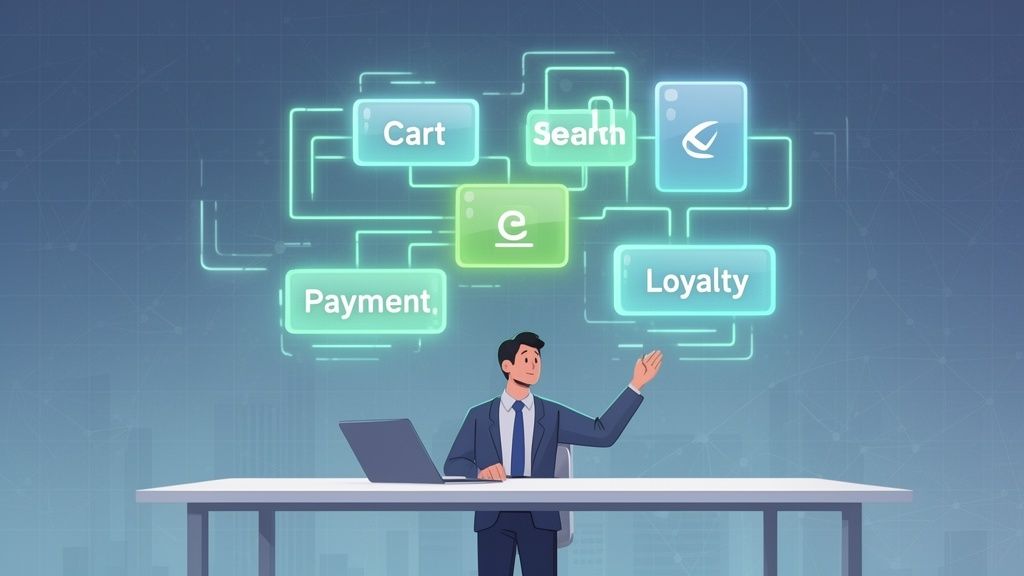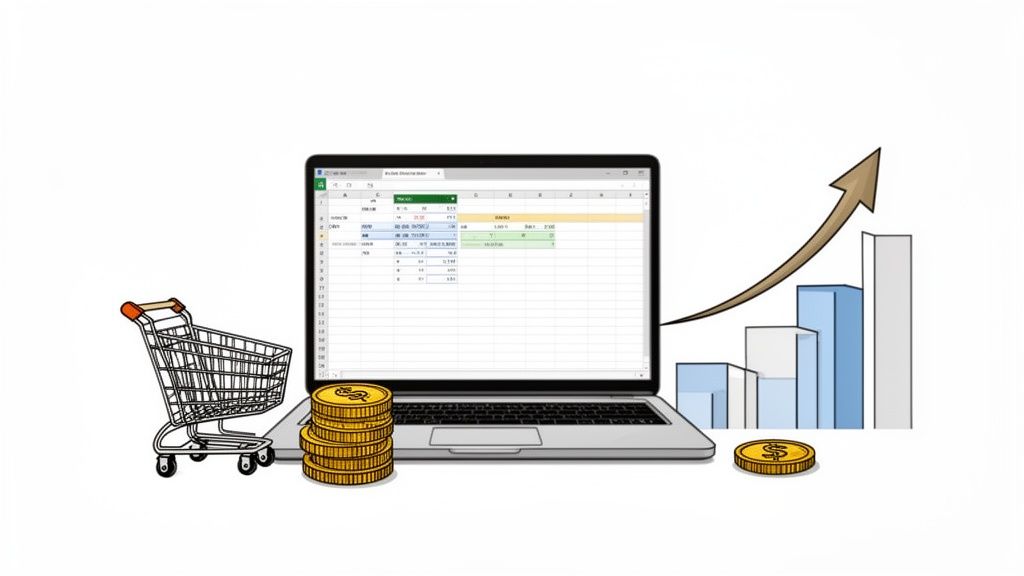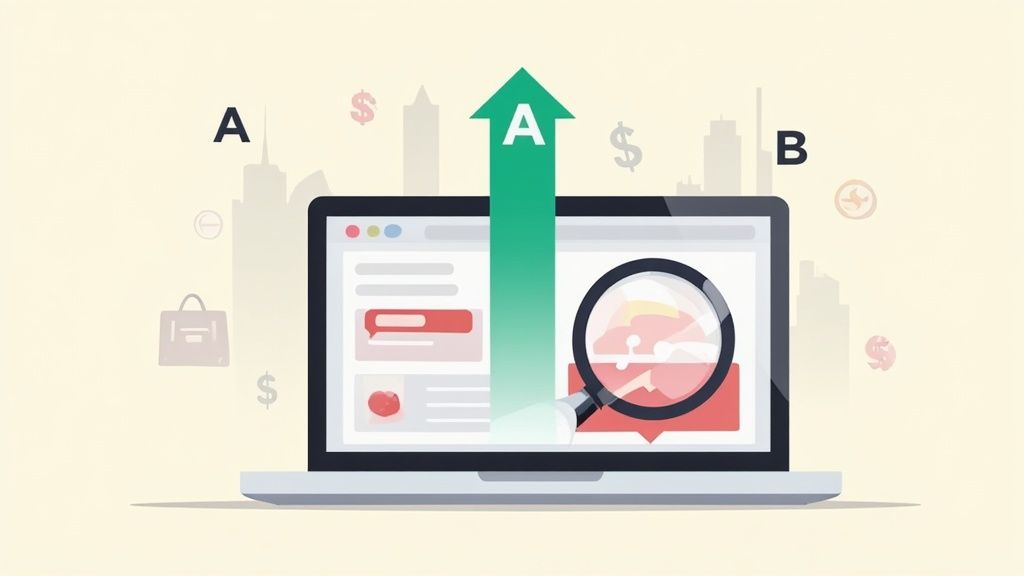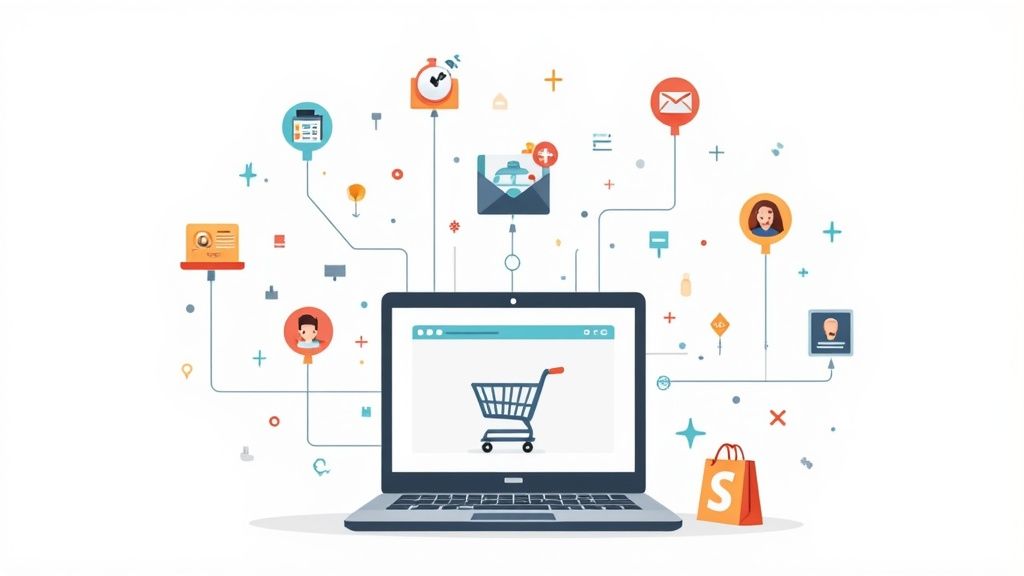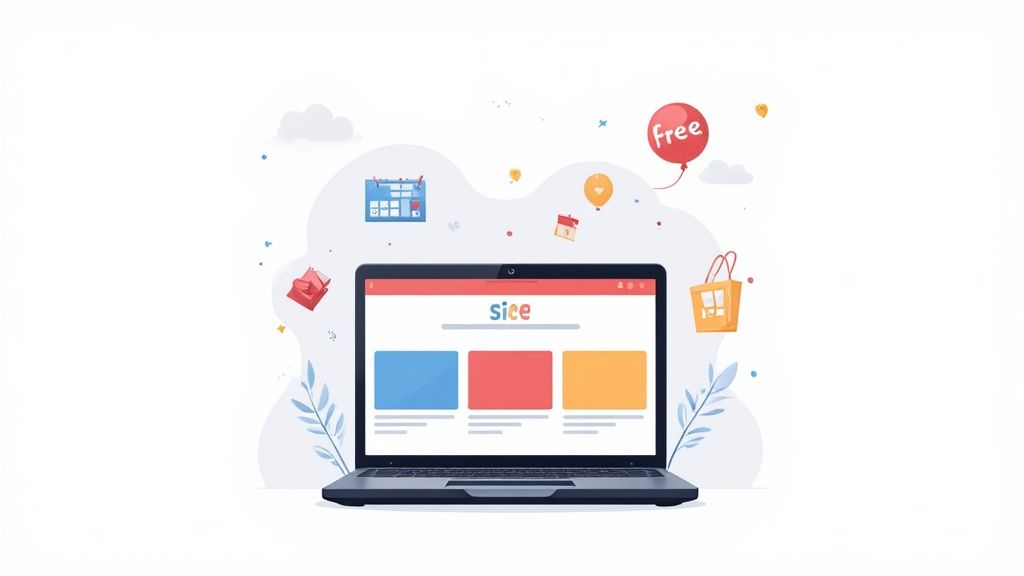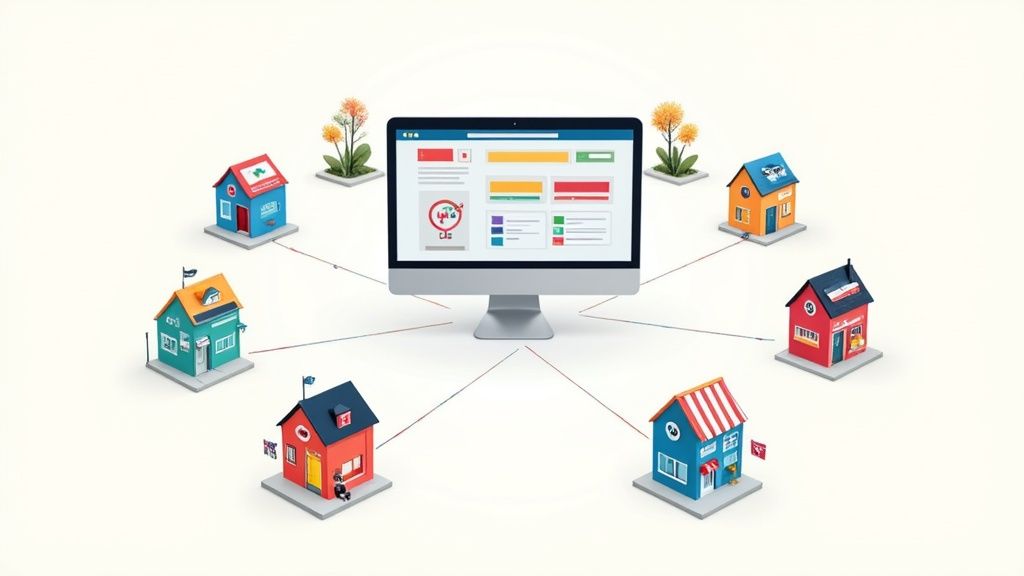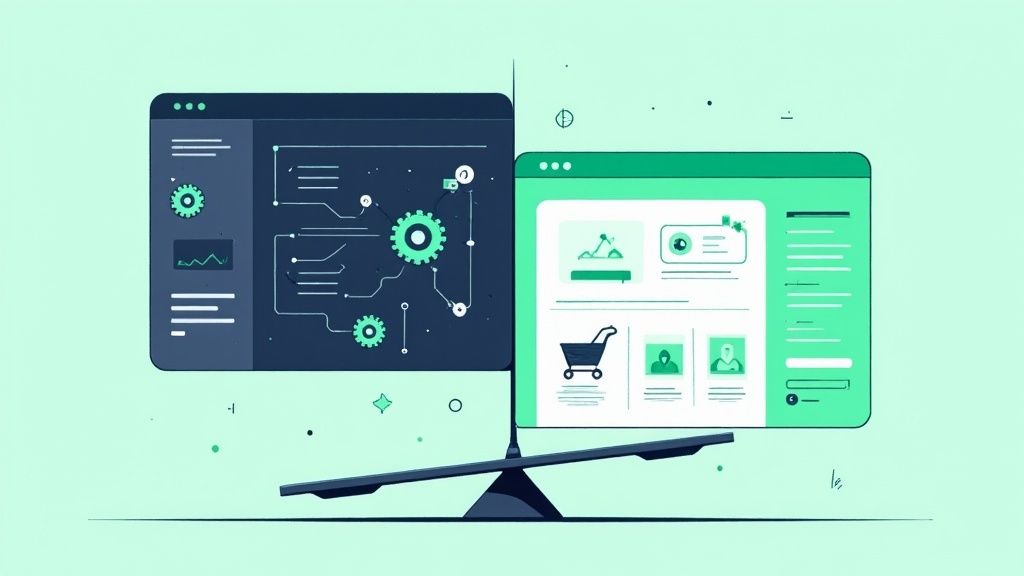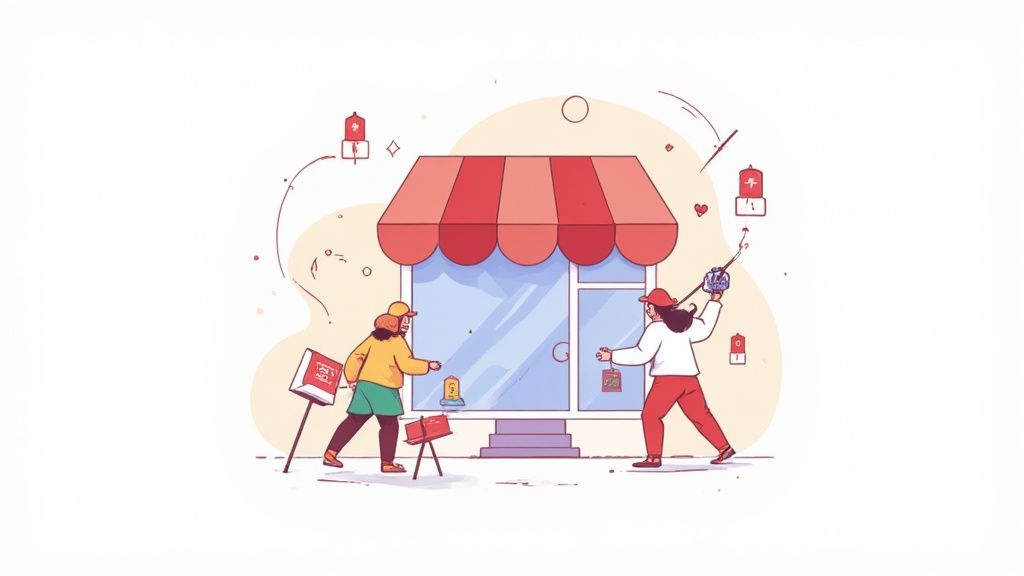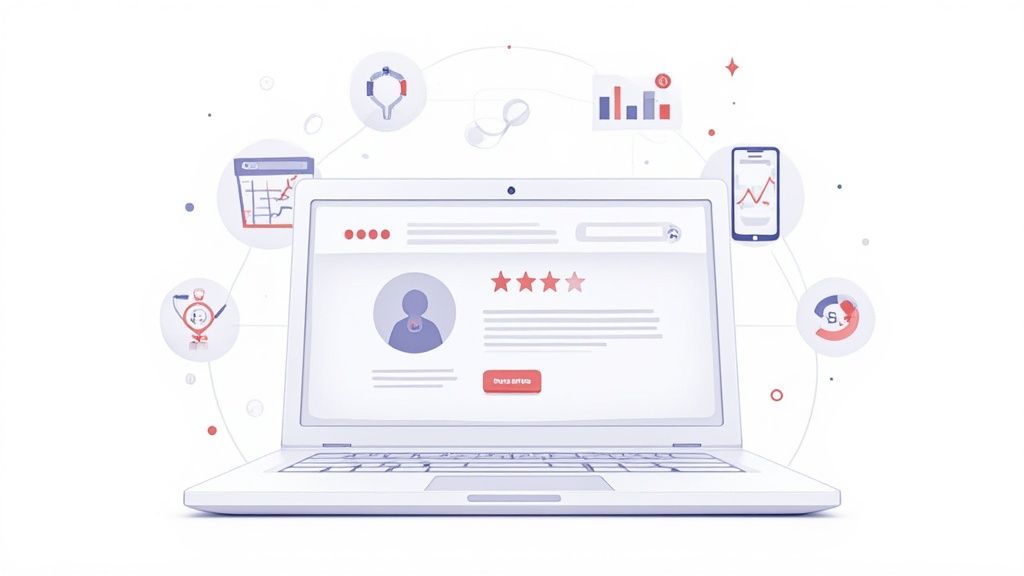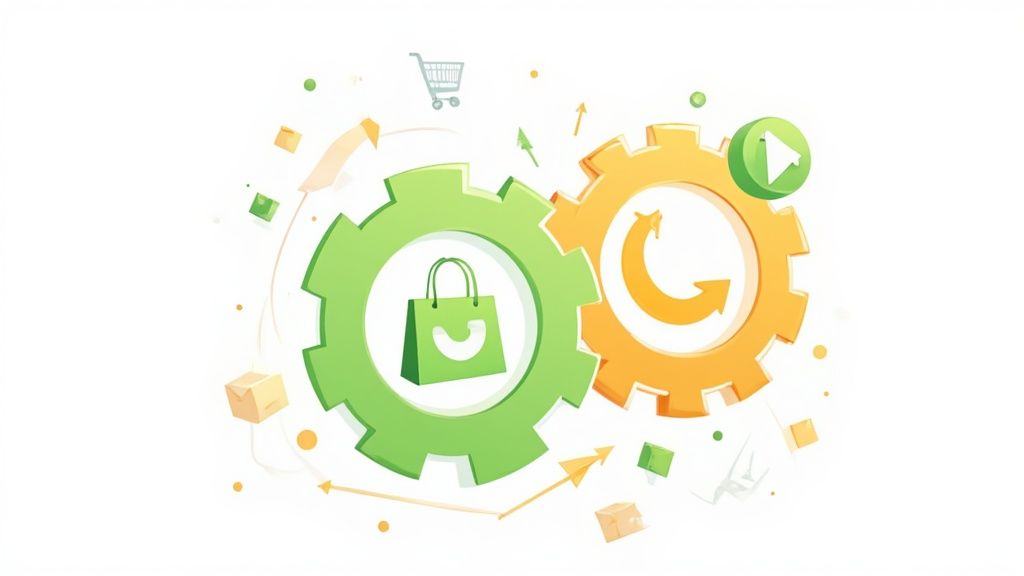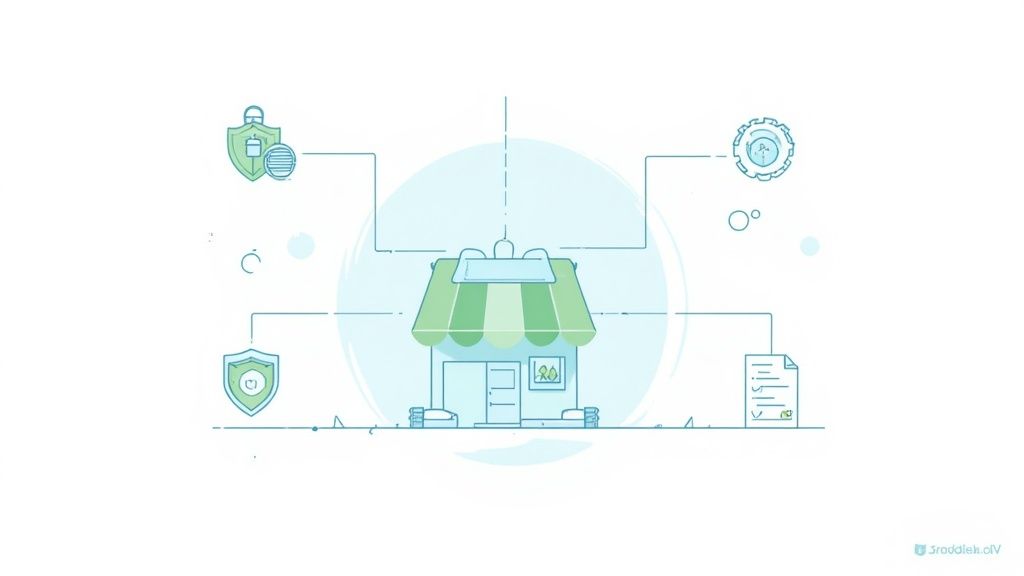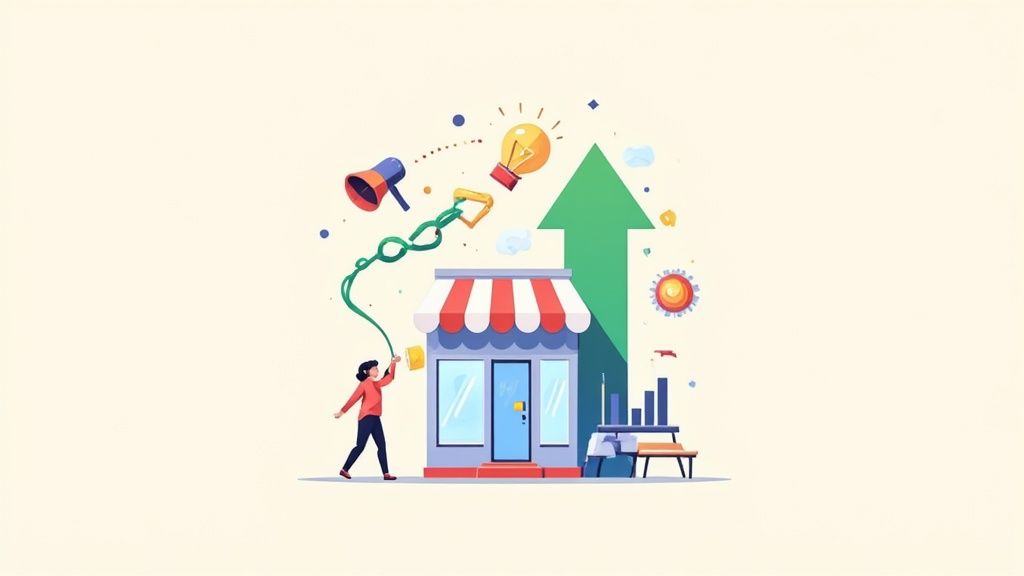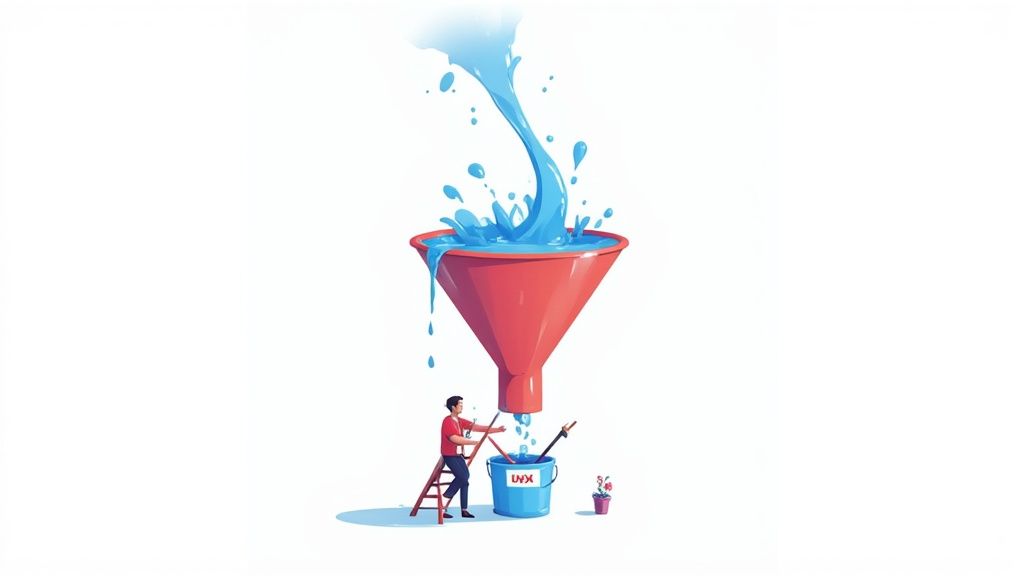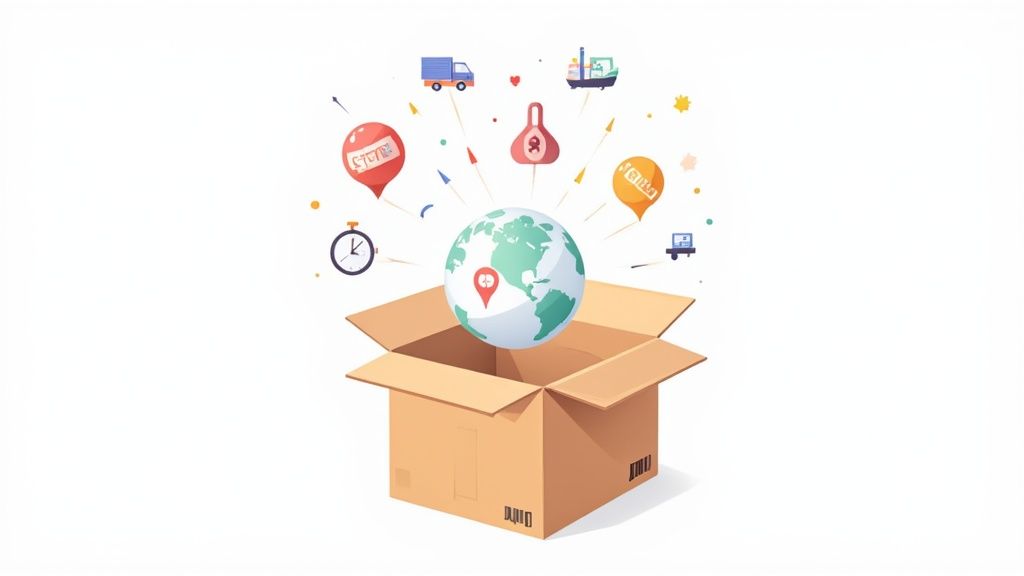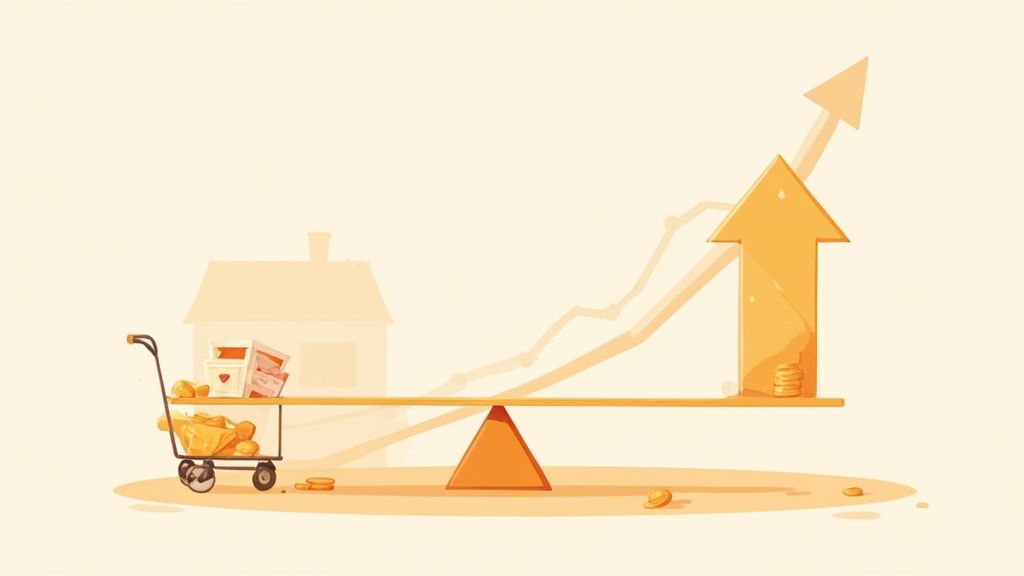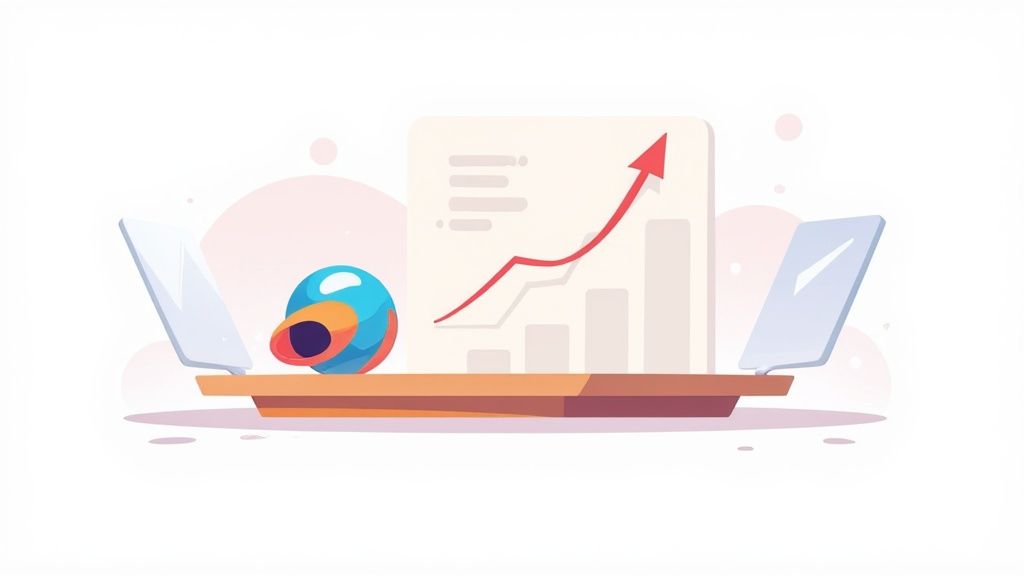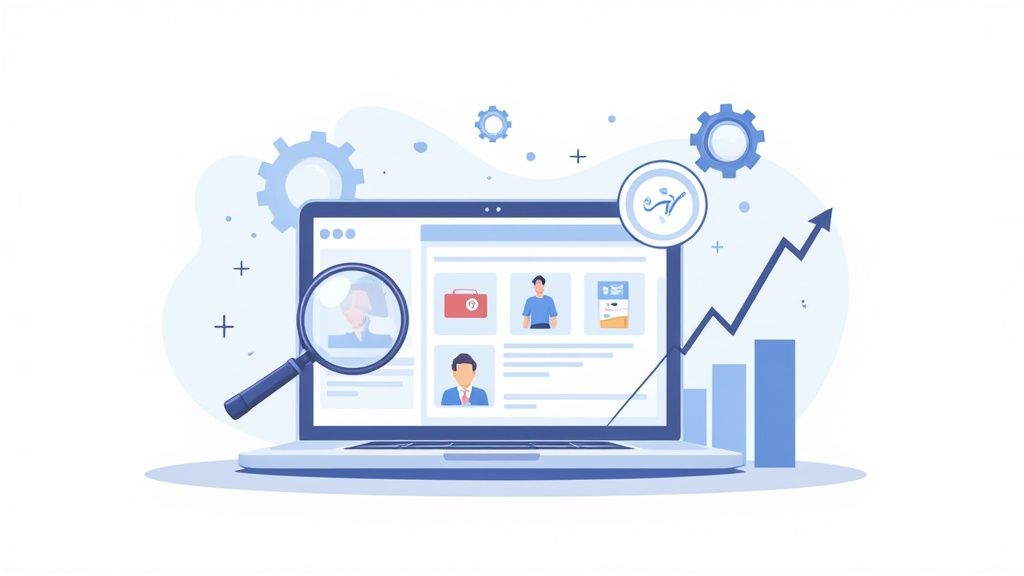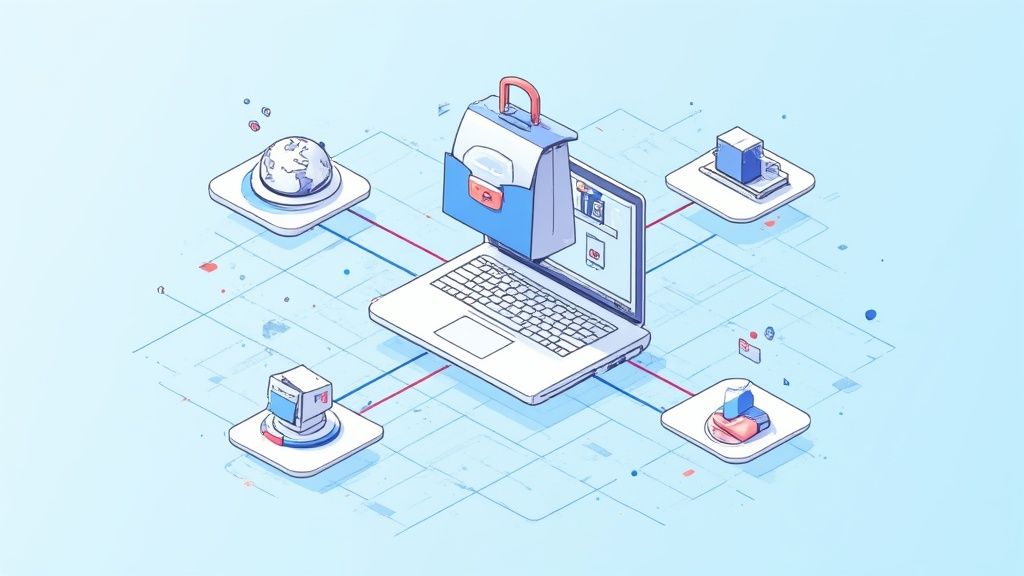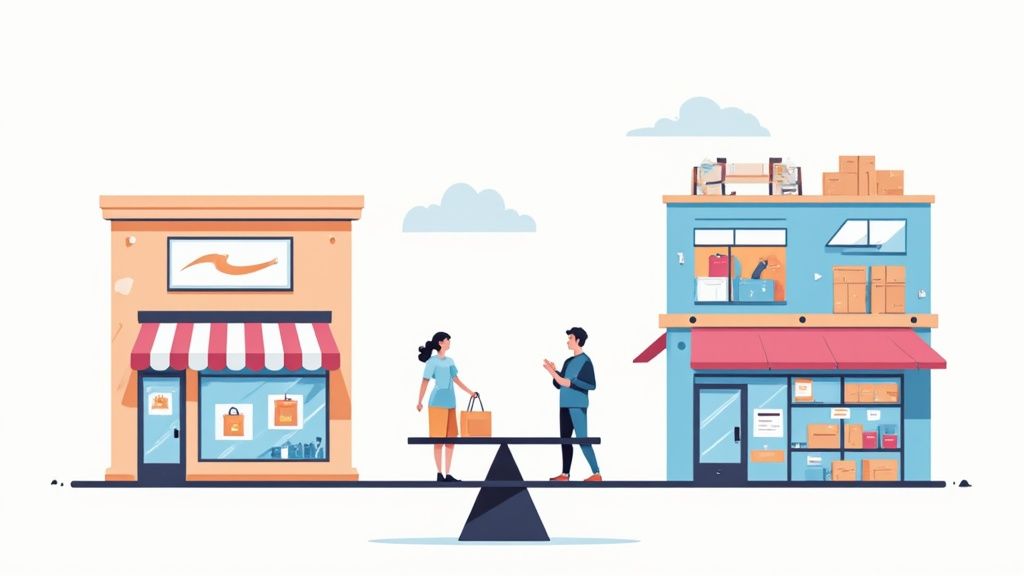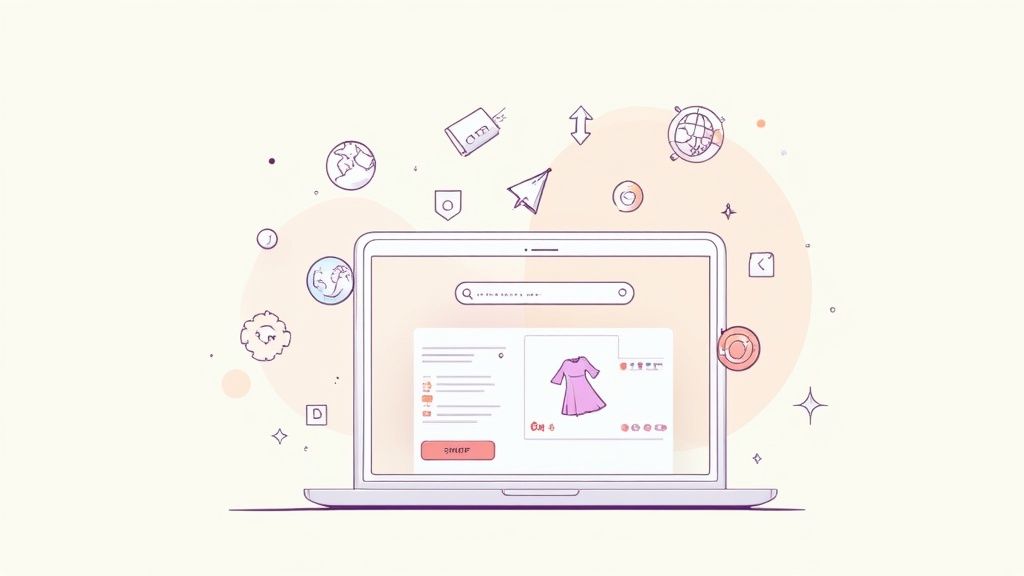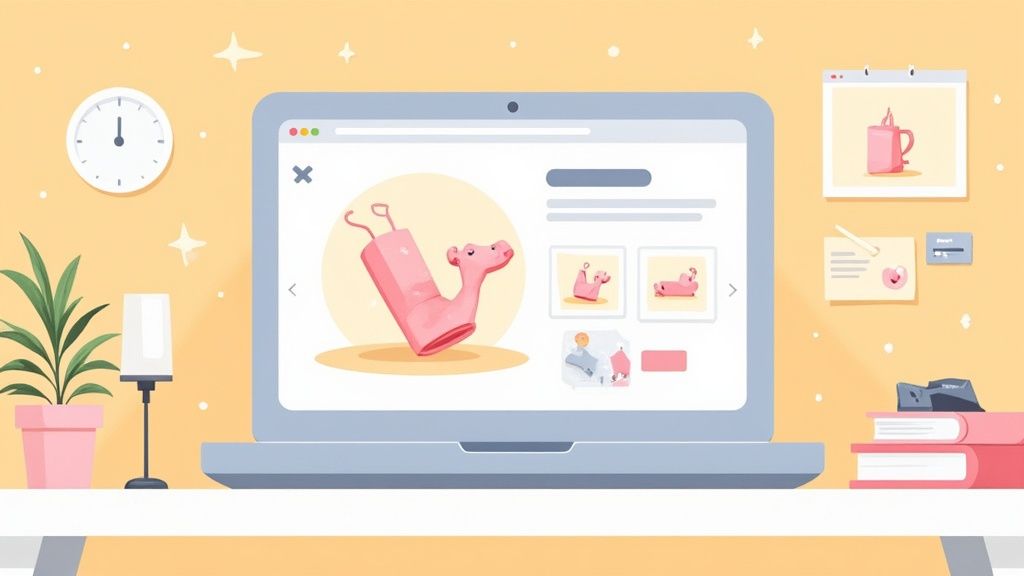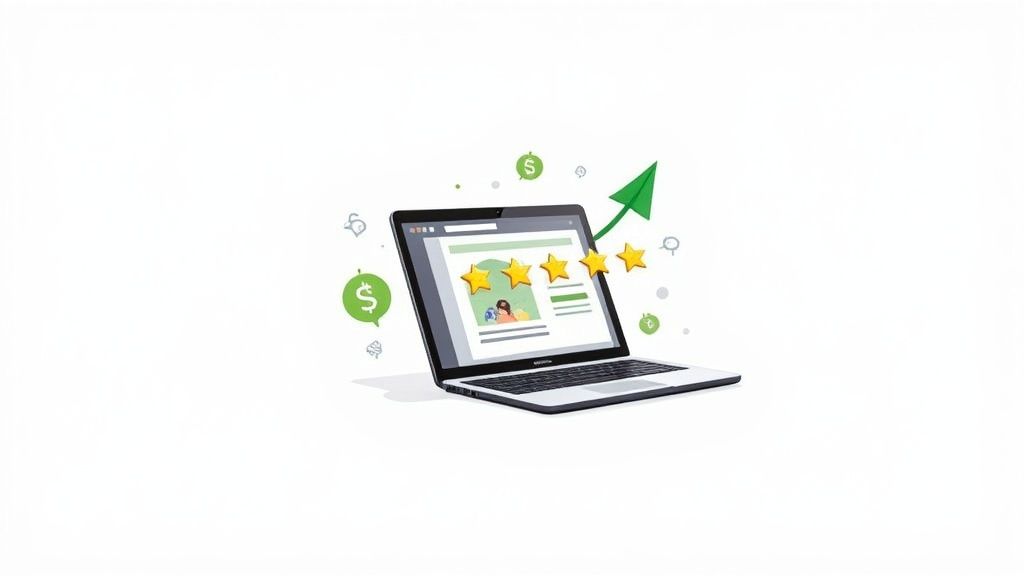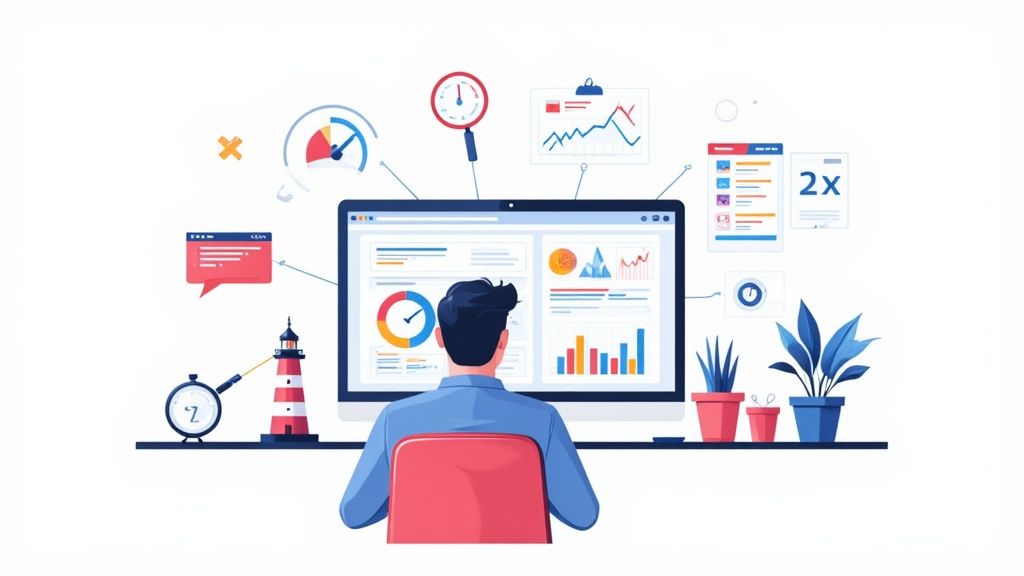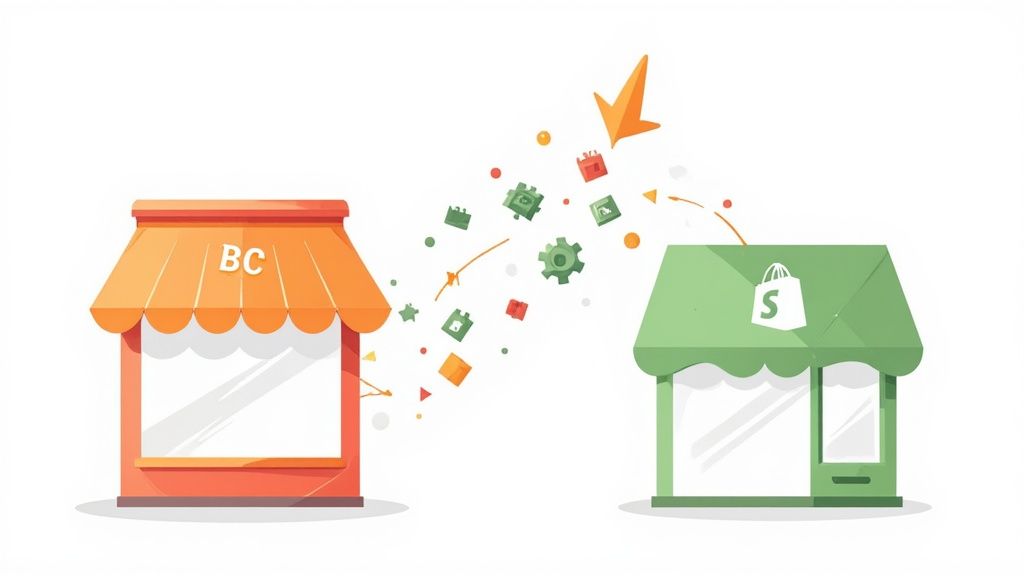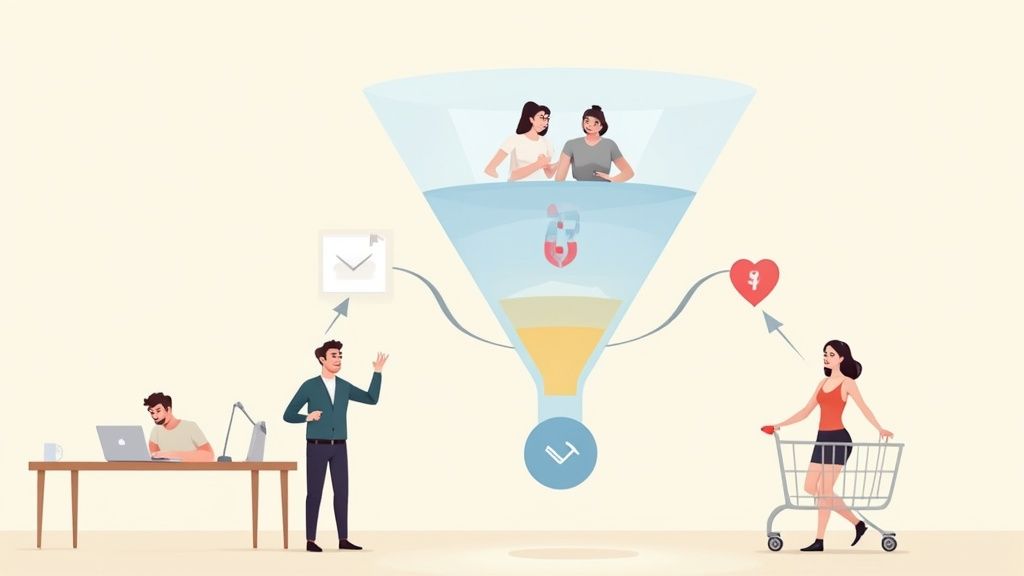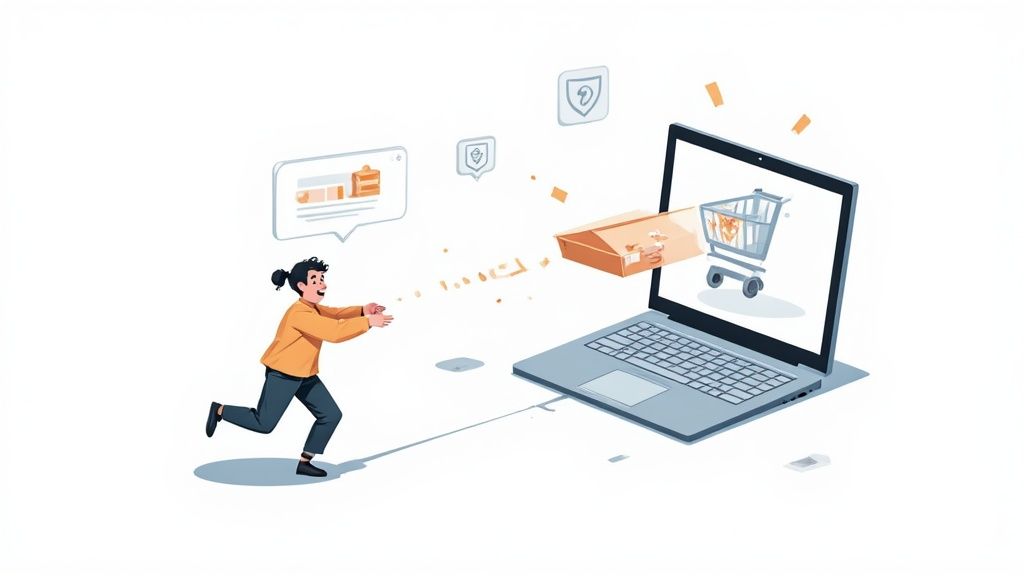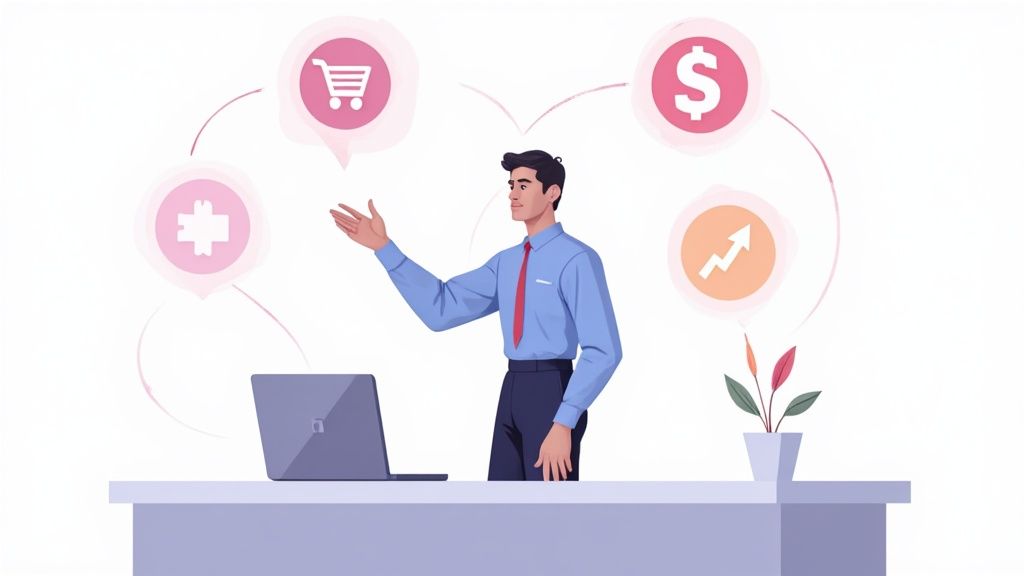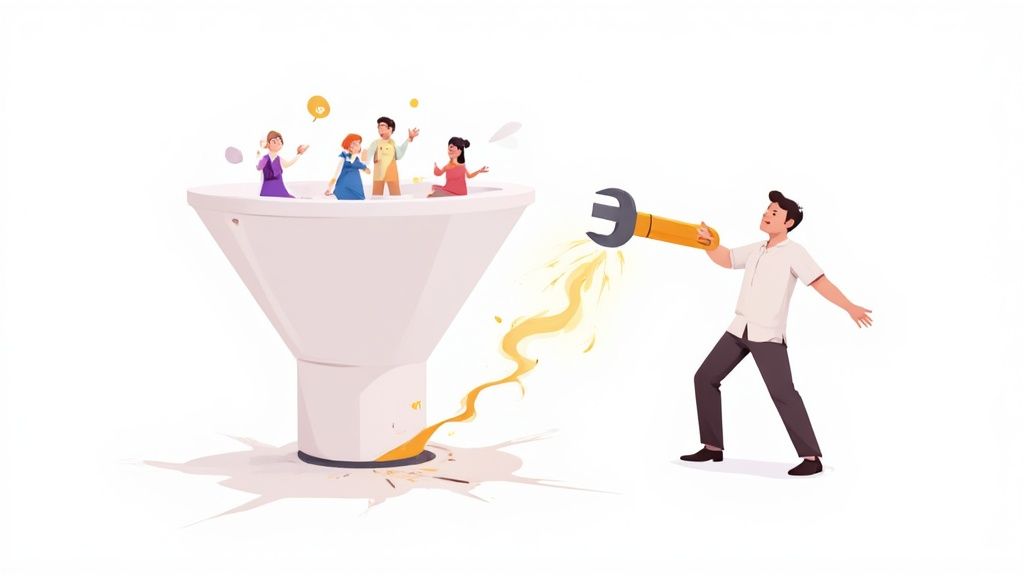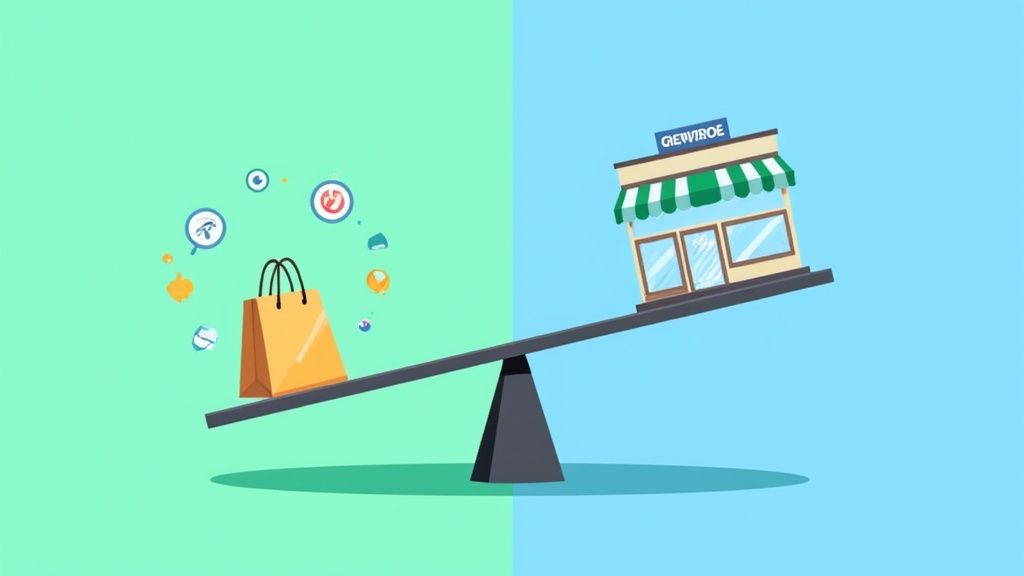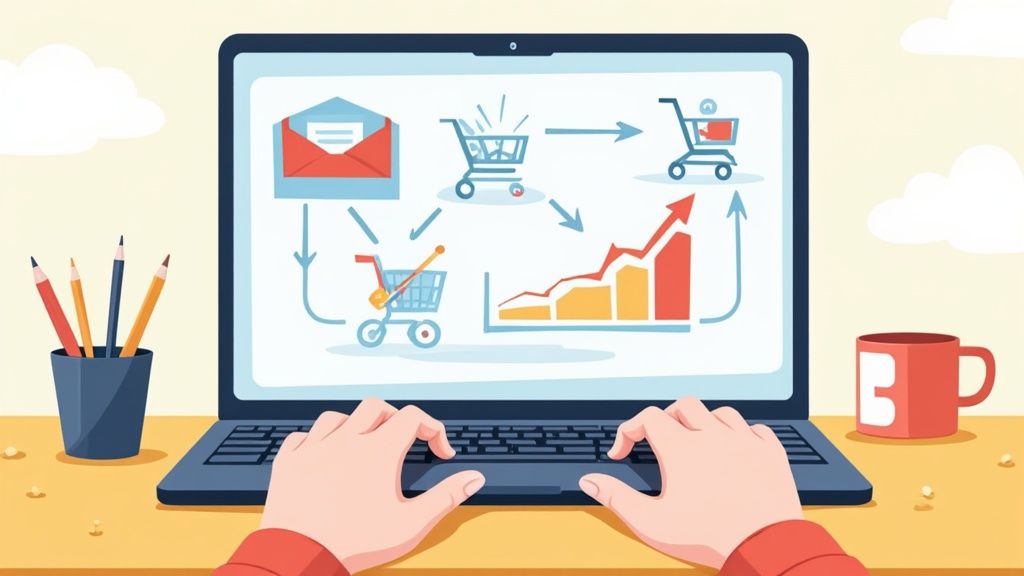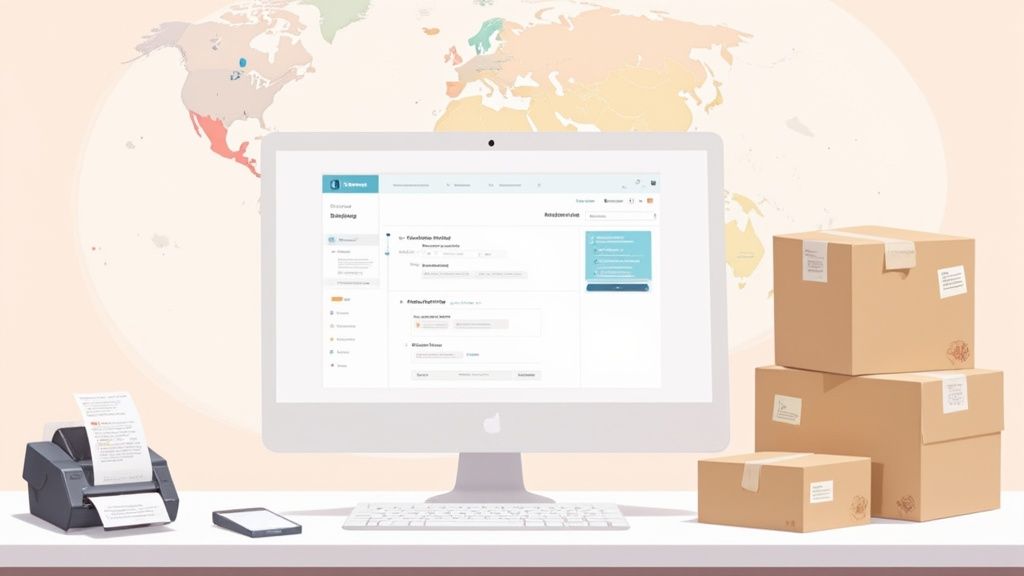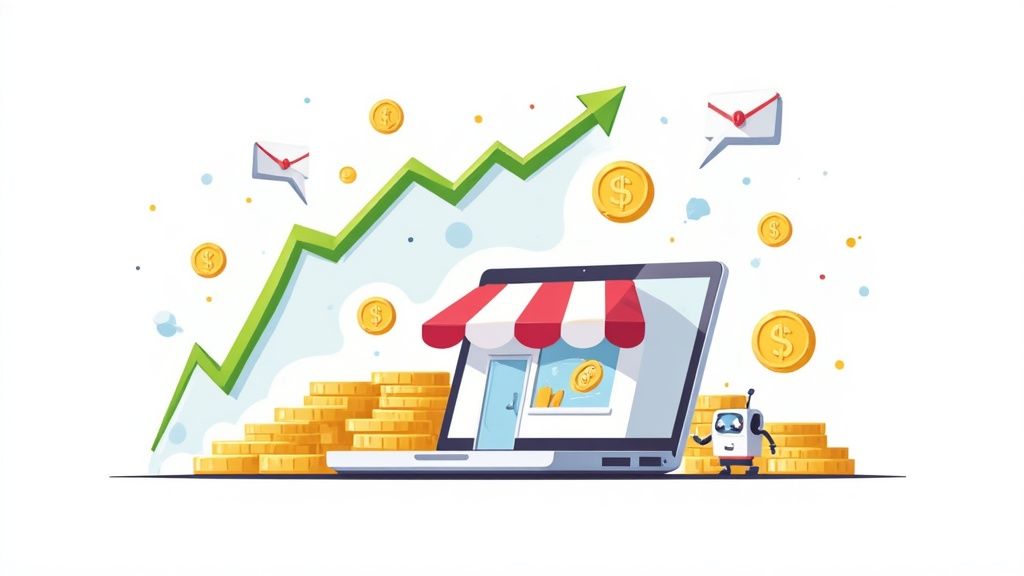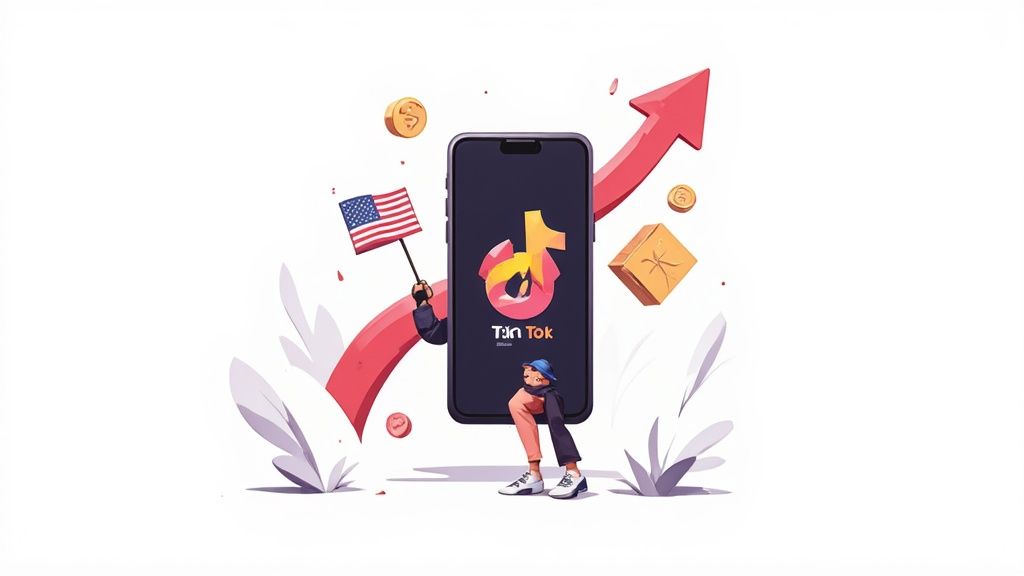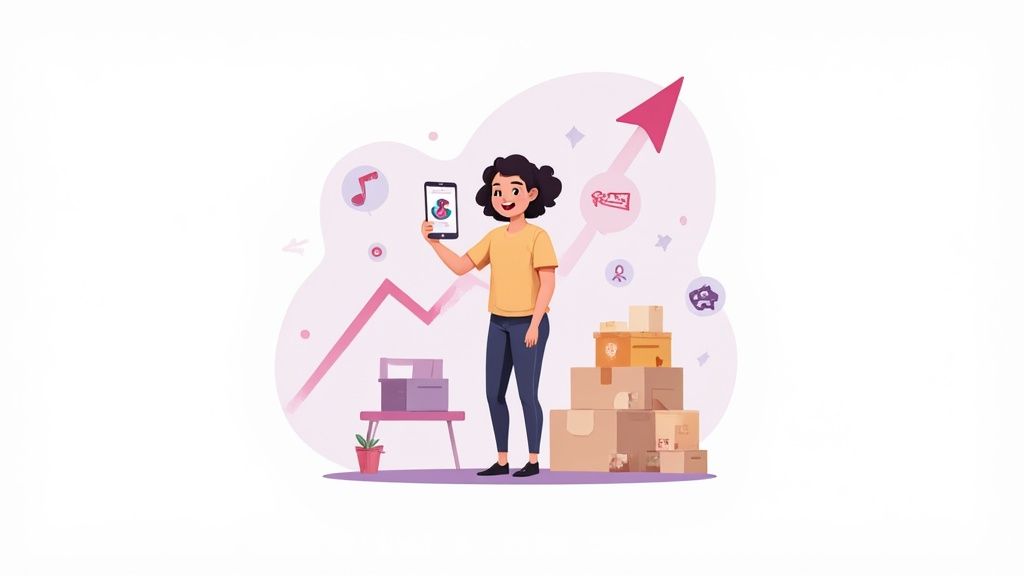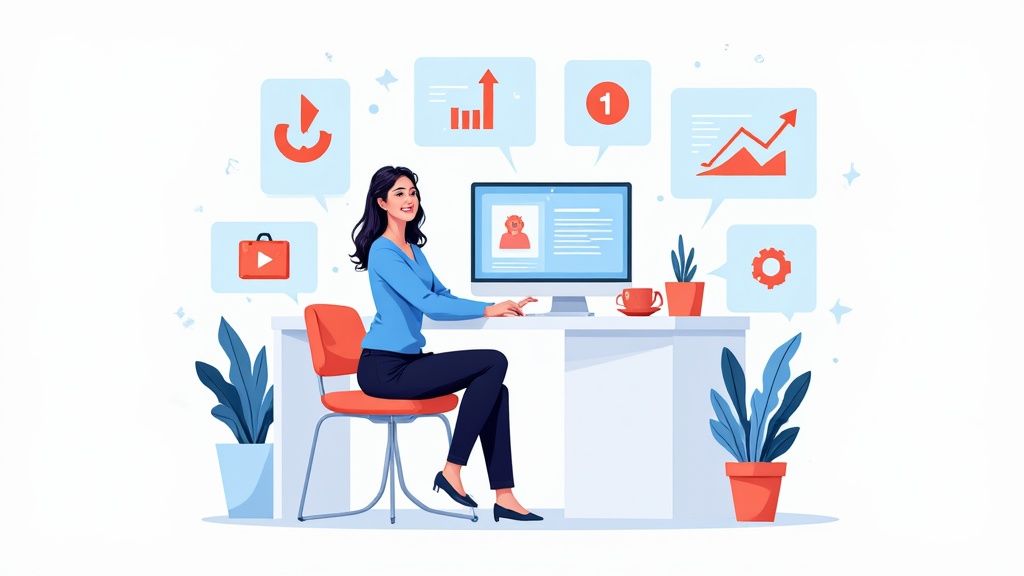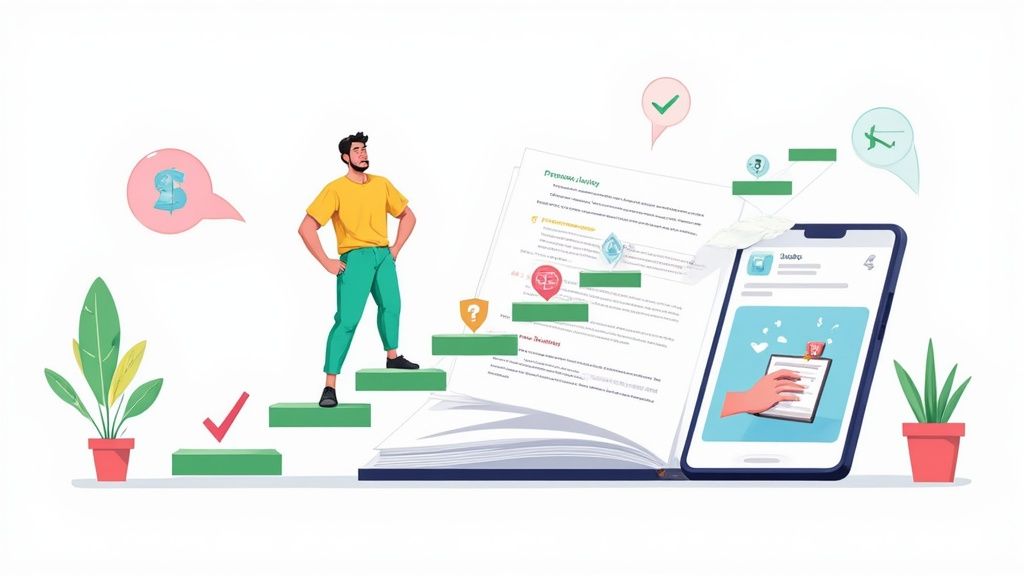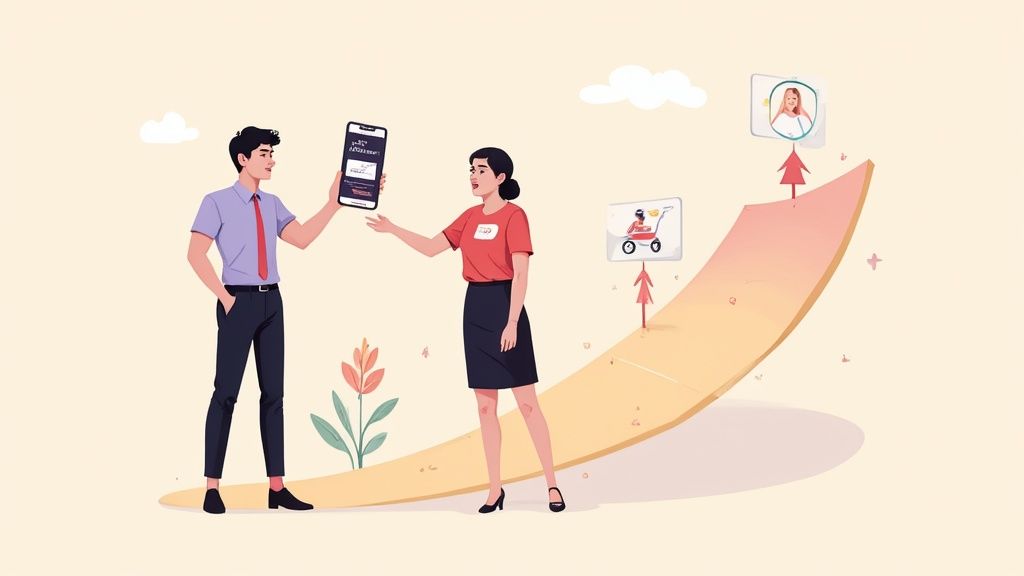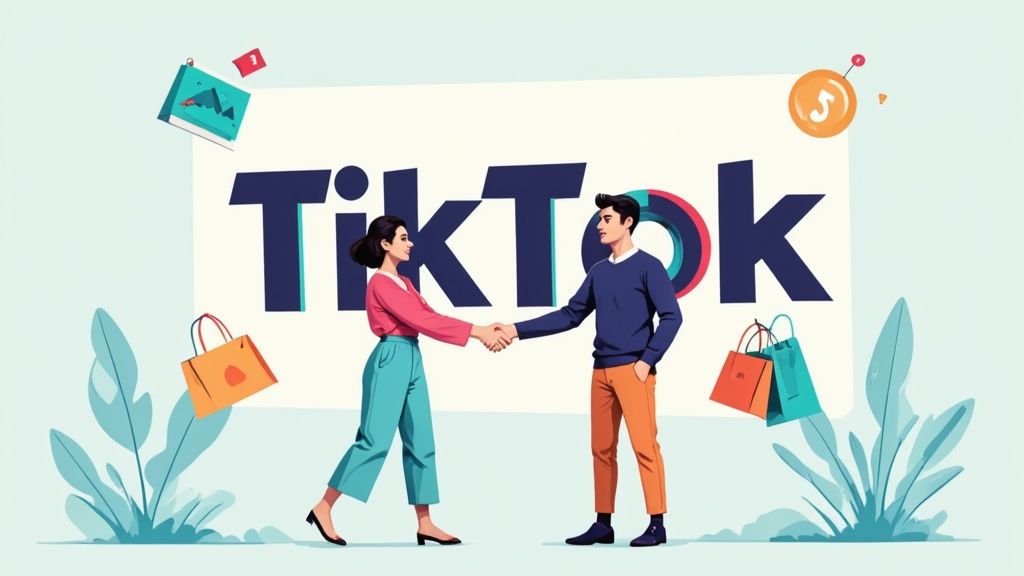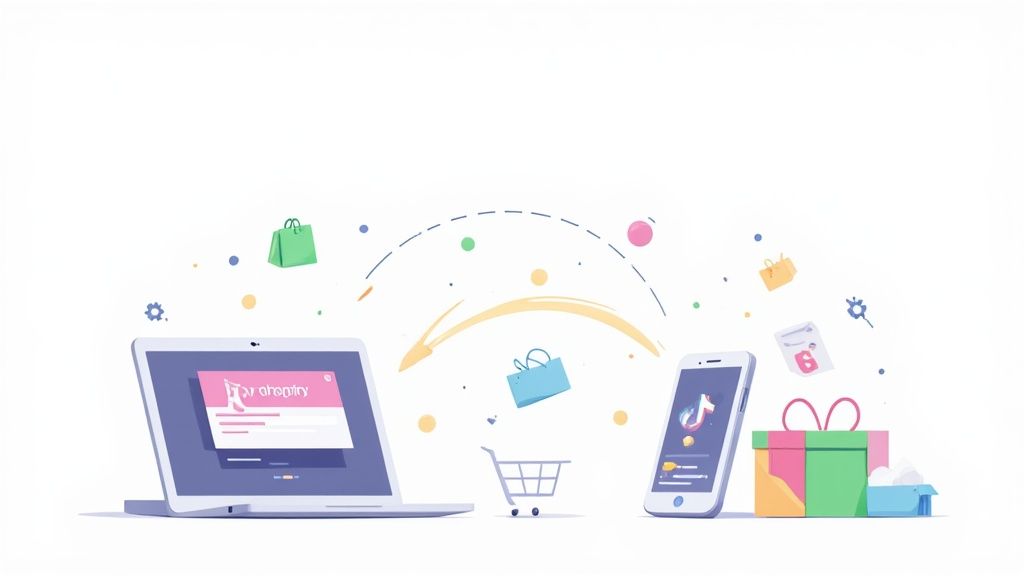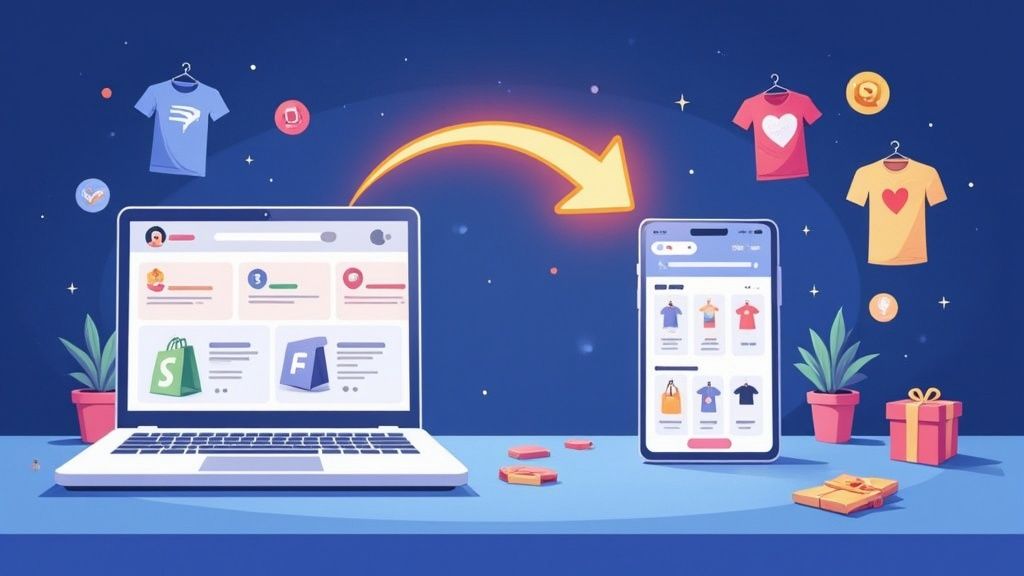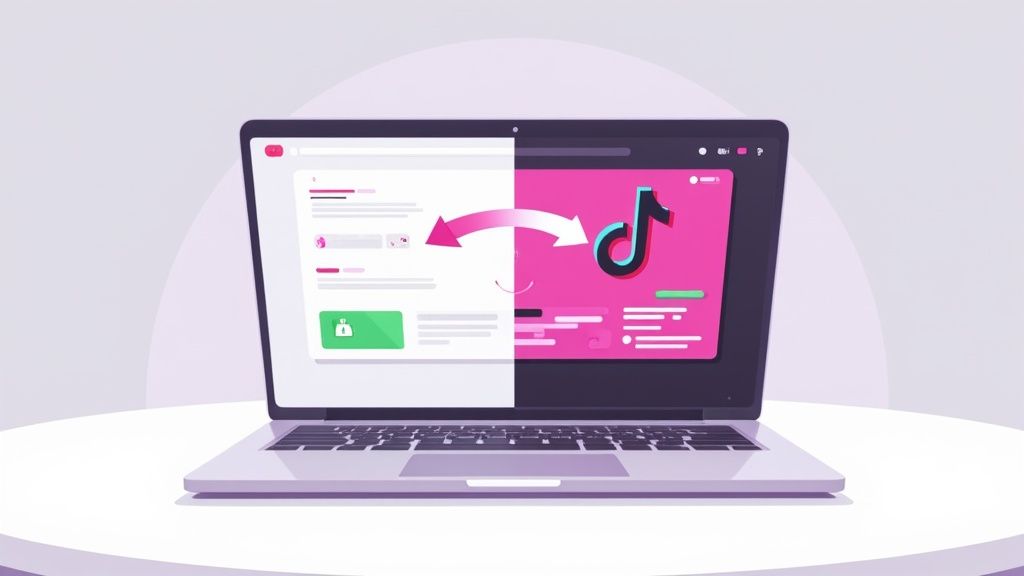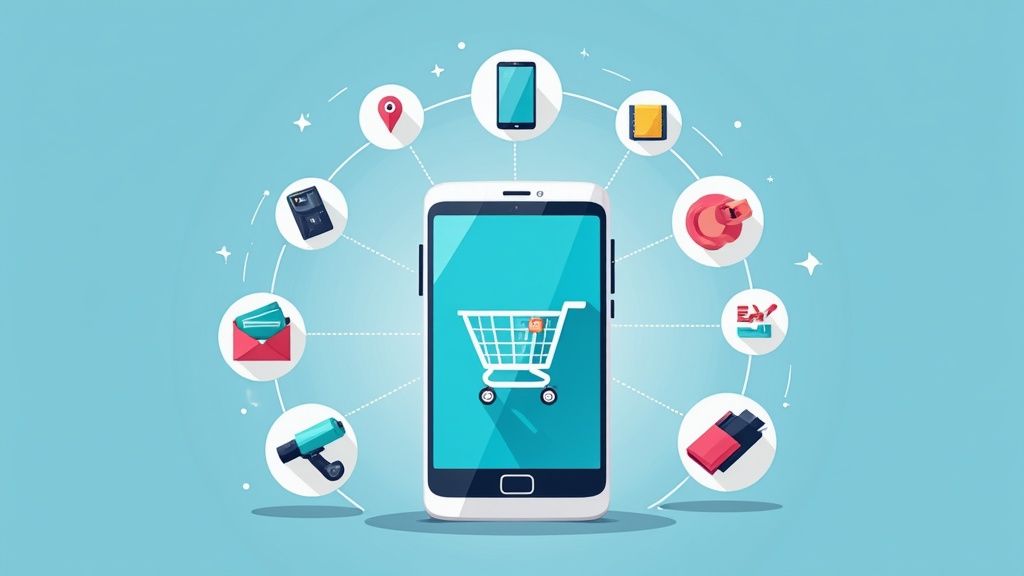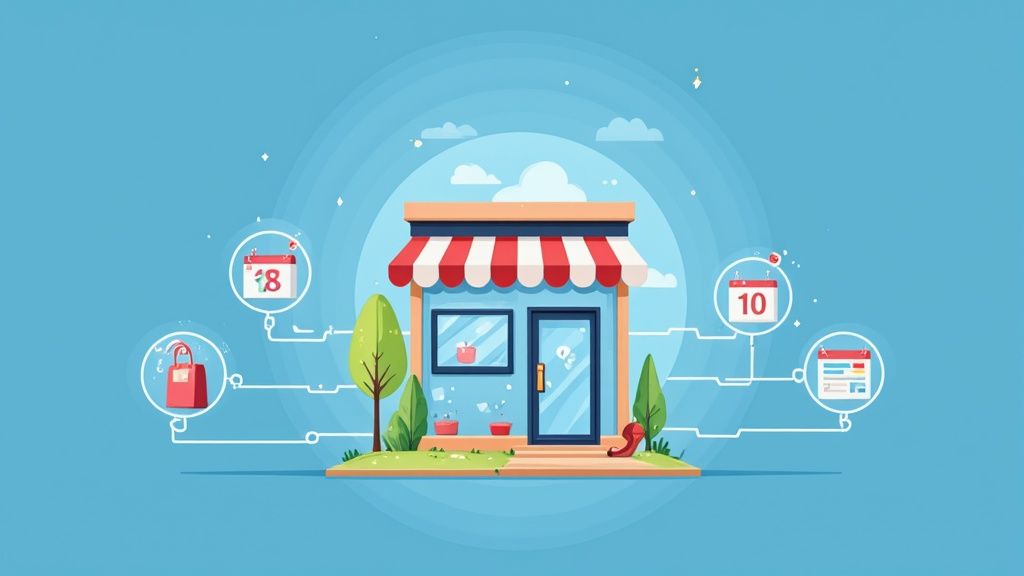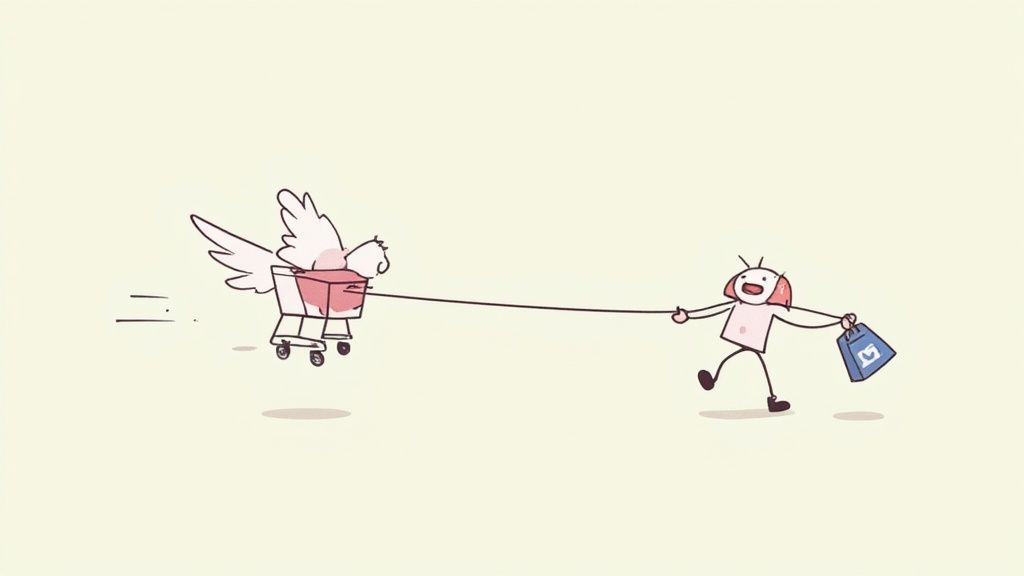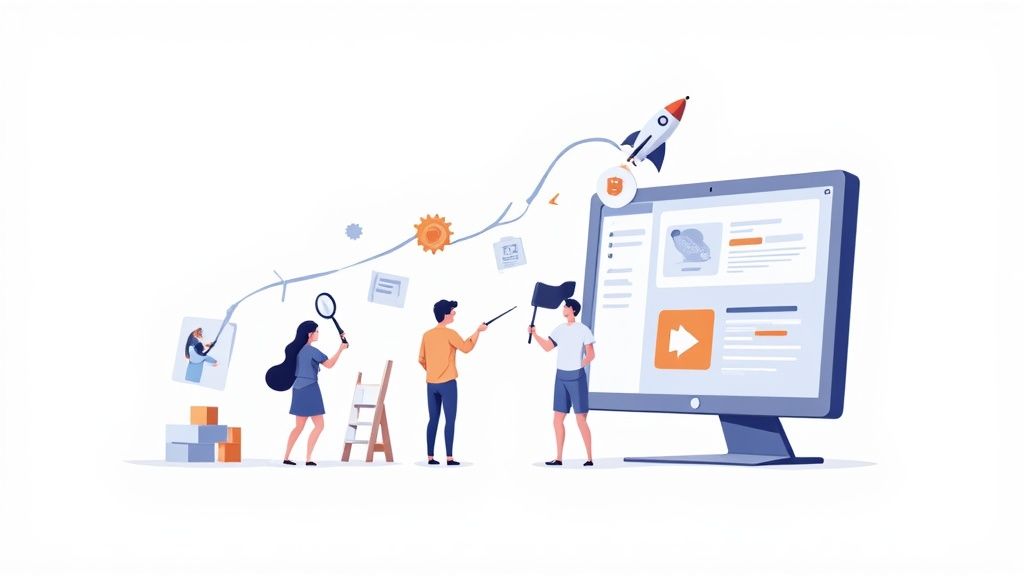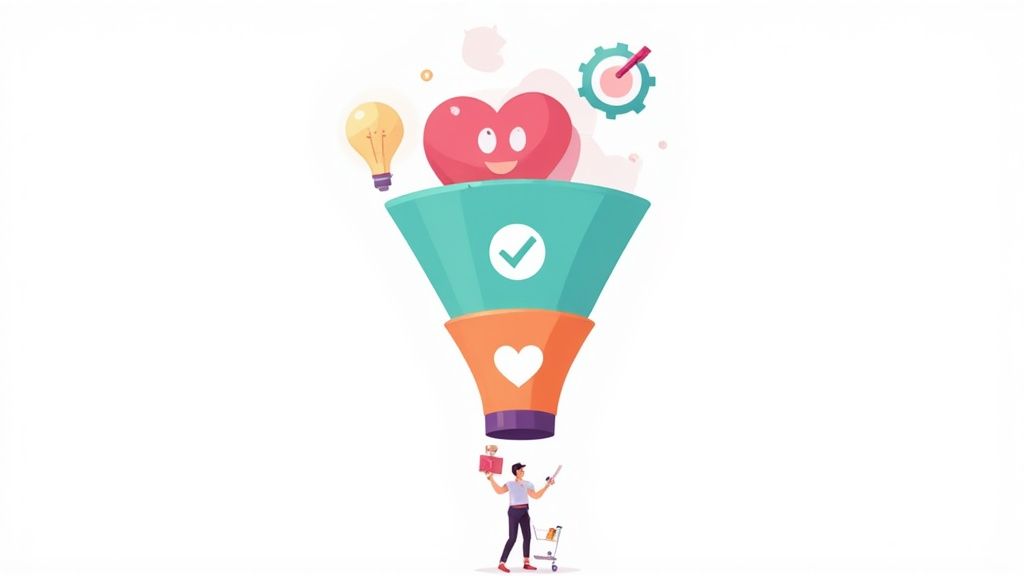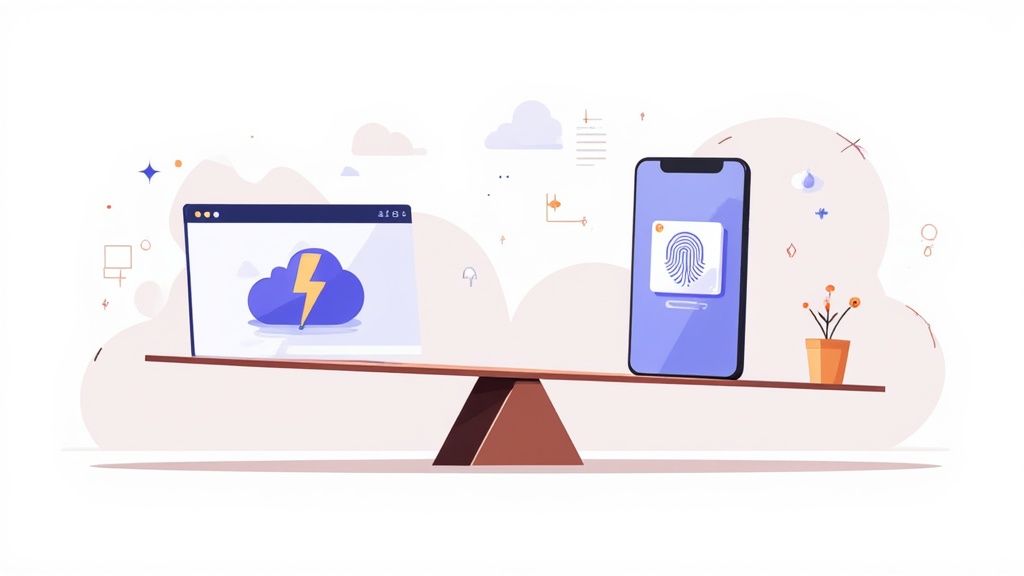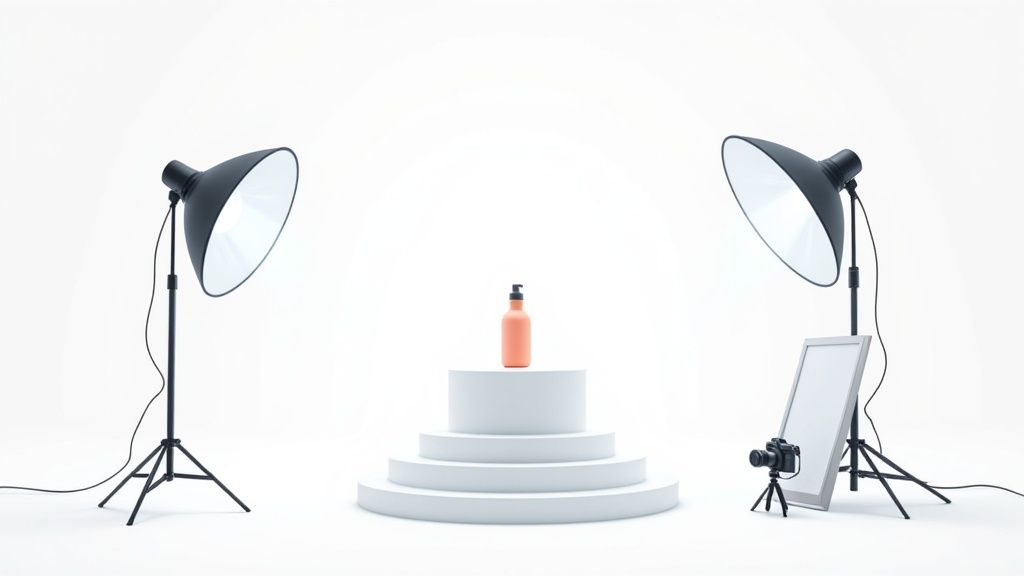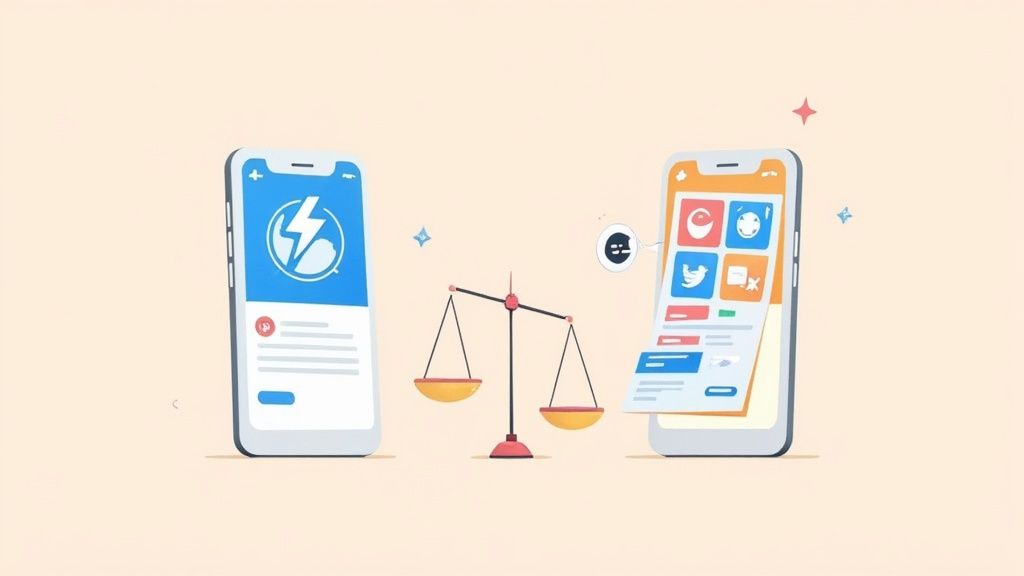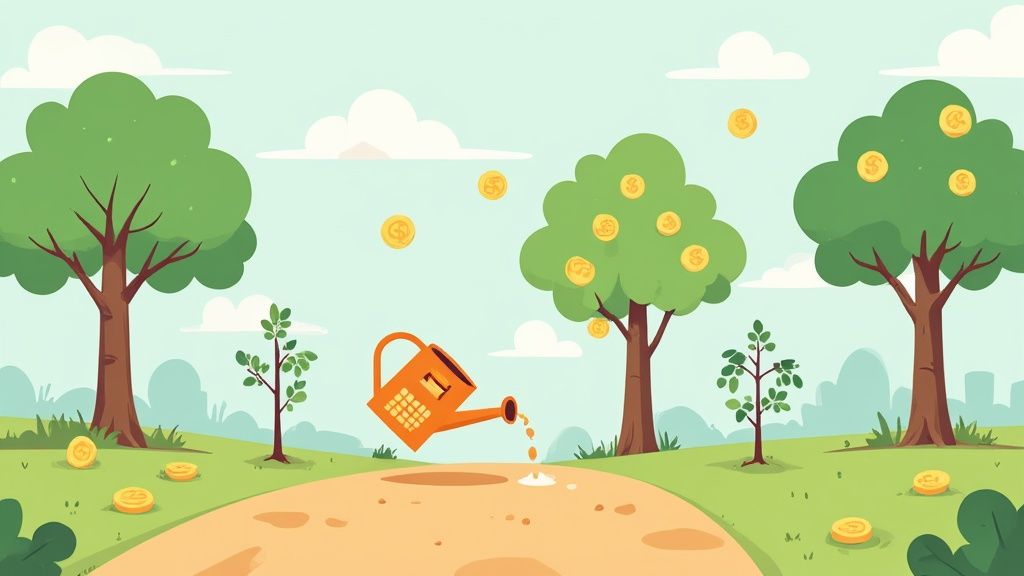
A customer acquisition cost calculator is a straightforward tool that nails down exactly how much you're spending to land each new customer. It simply divides your total sales and marketing spend by the number of new customers you brought in over a set time, giving you a crystal-clear picture of your return on investment.
What Is Customer Acquisition Cost and Why It Matters
Let's think of your business like an orchard. Every new customer is a tree you've managed to plant. Customer Acquisition Cost (CAC) is everything it took to get that tree growing—from the seeds and soil (your marketing campaigns) to the gardener's wages (your sales team's salaries). It’s the grand total you invested to win over a single new customer.
Getting a handle on this number isn't just for the accountants; it's about making smarter decisions that actually drive long-term profit and sustainable growth.
The Foundation of a Scalable Business
Knowing your CAC helps you answer some pretty critical questions. Are those Google Ads campaigns really making you money? Is your content marketing strategy paying for itself? Without tracking this cost, you're flying blind, throwing money at the wall and hoping something sticks.
A clear view of your CAC lets you:
- Allocate your budget effectively: You can finally pull money from those expensive, underperforming channels and double down on the ones that bring in great customers without breaking the bank.
- Optimize your marketing funnel: A high CAC can be a red flag, signaling friction somewhere in your customer's journey. By pinpointing where people are dropping off, you can patch the leaks and boost your conversion rates.
- Price your products intelligently: Your CAC is a real cost. It has to be covered by your pricing to make sure every sale is actually contributing to your bottom line, not just covering its own expenses.
Tracking CAC transforms your marketing from a cost center into a predictable growth engine. It gives you the hard data you need to justify investments, forecast future revenue, and build a business that can truly scale.
Ultimately, keeping a close eye on your customer acquisition cost is about maintaining the health of your orchard. It helps you figure out where to put your resources for the biggest harvest and stops you from wasting time on efforts that just won't bear fruit. A firm grasp on this number is the first real step toward building a more resilient and profitable company.
Breaking Down the CAC Formula
Before you can effectively use a customer acquisition cost calculator, you have to get a handle on what goes into it. The math itself is pretty simple, but its real power comes from feeding it accurate numbers.
At its core, the formula is refreshingly direct.
Customer acquisition cost = Total Marketing & Sales Costs ÷ Number of New Customers Acquired
Think of this equation as your North Star for measuring how efficiently you're bringing in new business. The real trick, though, is getting a clear picture of what "Total Costs" actually means and how you define a "New Customer."
This visual helps simplify the customer acquisition journey into three basic stages: the investment you make, the actions customers take, and the final outcome.
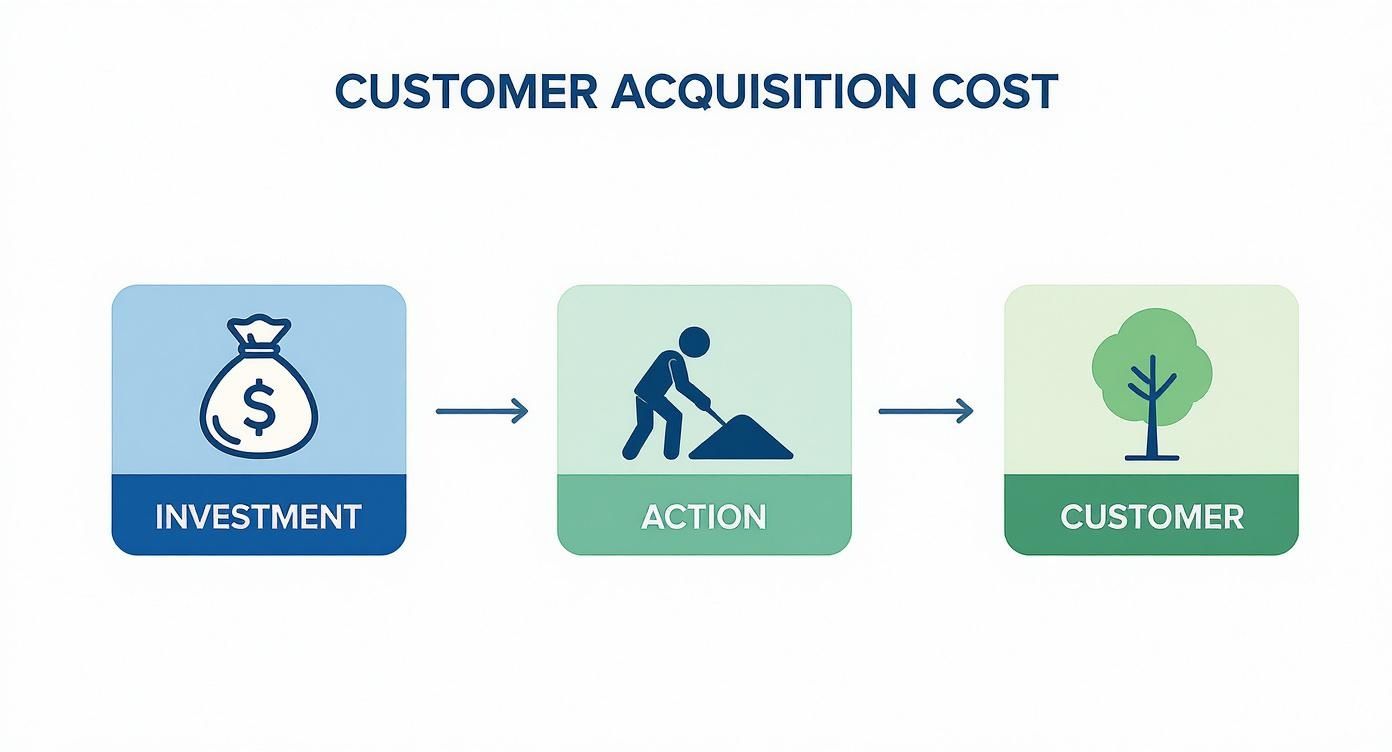
As the graphic shows, getting a new customer isn't magic; it’s a process that starts with a financial investment and, hopefully, ends with a paying customer.
Uncovering Your True Marketing and Sales Costs
It’s tempting to just plug in your ad spend and call it a day, but that’s a rookie mistake. Only counting direct advertising costs gives you a skewed, overly optimistic CAC that doesn’t reflect reality. A truly accurate calculation needs to capture every single expense that goes into winning a new customer.
To get the full picture, you need to tally up all the moving parts. This table breaks down the common expenses that should be part of your "Total Costs."
By being thorough here, you ensure your CAC is grounded in the financial reality of your business, not just a surface-level guess.
Defining "New" Customers and the Time Period
The other side of the equation—the number of new customers—is just as important. You need a rock-solid definition of what a "new" customer is. If you accidentally include repeat buyers, you'll artificially deflate your CAC and make your acquisition efforts look more effective than they really are.
You also have to make sure your costs and new customers are aligned over the same period. Whether you calculate CAC monthly, quarterly, or annually, consistency is key. The costs you include must directly correspond to the customers you acquired during that exact timeframe.
Let’s walk through a quick example. Imagine a local coffee shop spends $5,000 in one month. This covers their local Facebook ads, the salary of their part-time marketing person, and their email software subscription.
In that same month, they get 250 brand-new customers to make their first purchase.
Here’s how their CAC calculation would look:
$5,000 ÷ 250 = $20 per new customer
When you track both sides of this equation with this level of detail, you move from vague estimates to a precise, actionable metric. This clarity is what allows you to make smart decisions about where to invest your next marketing dollar and build a truly profitable growth engine.
Using a Customer Acquisition Cost Calculator
Let's be honest, manually calculating metrics in a spreadsheet is a drag. It’s slow, tedious, and one wrong cell can throw everything off. This is where an interactive customer acquisition cost calculator comes in—it’s like upgrading from a flip phone to a smartphone for your marketing analytics.
A good calculator automates the entire formula, taking all your messy data and spitting out a single, clean number in seconds. This frees you up to spend less time crunching numbers and more time actually using them to make smarter decisions.
The beauty of a calculator is its speed and simplicity. No more hunting for the right formula or double-checking your math. You just plug in a few key figures, and you're done. This speed not only removes the risk of human error but also gives you an immediate, clear snapshot of how efficiently you're winning new business.
How to Use the Calculator
Using a CAC calculator is incredibly straightforward. It boils down to a simple three-step process designed to give the tool exactly what it needs to do the heavy lifting for you.
Here's the quick rundown:
- Define Your Time Period: First, decide on the timeframe you want to measure. Are you looking at last month? The last quarter? The whole year? The key here is consistency, so pick a period that matches up with your regular business reporting.
- Enter Your Total Costs: Next, tally up all your sales and marketing expenses for that period. Be thorough. This includes everything from ad spend and team salaries to software tools and one-off creative costs. The more accurate your input, the more trustworthy your CAC will be.
- Add Your New Customers: Finally, enter the total number of brand-new customers acquired during that same timeframe. It's crucial to only count new customers here—including returning ones will muddy the waters and give you a misleading result.
Once those three fields are filled out, the calculator will instantly show you your CAC.
Here’s a peek at what a typical customer acquisition cost calculator looks like. Notice the simple fields for your expenses and new customer count.
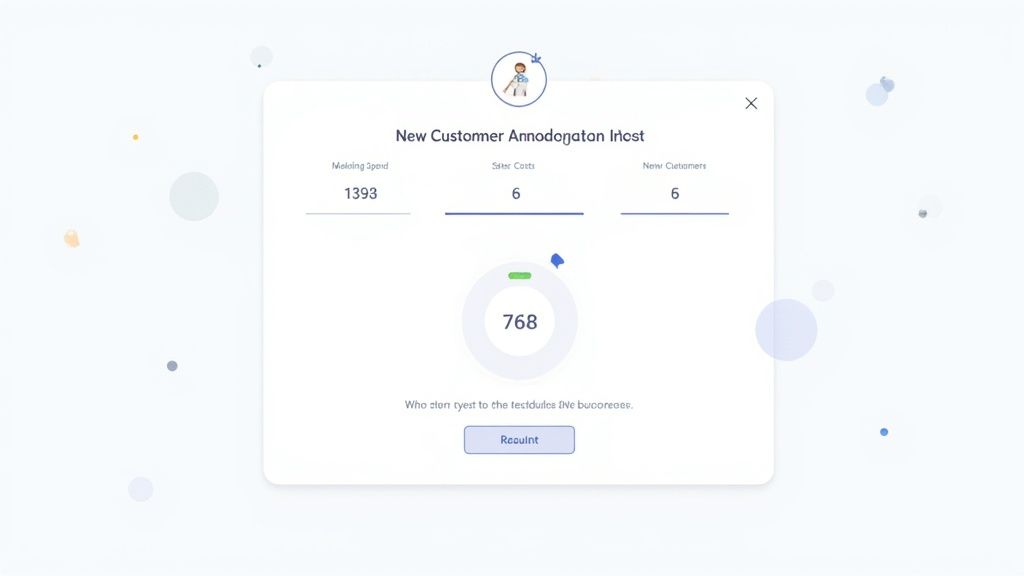
As you can see, it's designed to be clean and intuitive, turning raw numbers into a clear performance metric without any fuss.
Putting the Calculator into Practice
Let's walk through a real-world example. Imagine an eCommerce store spent $10,000 on marketing and another $5,000 on sales salaries last quarter. During that time, they brought in 500 new customers.
By plugging those numbers into a customer acquisition cost calculator—a total cost of $15,000 and 500 new customers—the tool would instantly calculate their CAC as $30.
This kind of immediate feedback is what makes a calculator so powerful. It lets you track your CAC over time, making it easy to spot trends. Is your CAC creeping up? That could be a sign of ad fatigue or new competition, signaling it's time to adjust your strategy. Is it dropping? A new campaign might be a runaway success, giving you the data-backed confidence to double down on what’s working.
At the end of the day, a calculator isn’t just about getting a number. It’s about building a repeatable, reliable process for keeping an eye on one of your most critical growth metrics. With a tool like this, you can make faster, more informed decisions about where to put your money, ensuring every dollar you spend is working as hard as possible to grow your business.
So you’ve run the numbers and have your Customer Acquisition Cost staring back at you. Now what? The first question everyone asks is, "Is this a good number?"
The honest answer? It depends. Your CAC doesn't live in a bubble. A figure that’s fantastic for one company could spell disaster for another.
Think of it like a car's gas mileage. Getting 15 miles to the gallon isn't necessarily "bad" for a high-performance sports car, but it would be a huge red flag for a tiny compact. It’s all about context. A high CAC isn't an automatic problem if you're pulling in highly valuable customers who stick around for the long haul.
Benchmarking Against Your Industry
One of the best ways to get some perspective is to see how you stack up against others in your field. Acquisition costs swing wildly from one industry to another, driven by things like the complexity of your sales cycle, product price points, and just how crowded your market is.
The SaaS world is a perfect example of this range. Data from 2025 shows eCommerce SaaS companies can have an average CAC as low as $274. On the flip side, fintech companies are looking at costs hitting $1,450 per customer. That gap makes perfect sense when you think about it—selling a simple inventory tool is a much lighter lift than convincing someone to trust you with their entire financial life. Dig into more industry CAC benchmarks on gocustomer.ai to get a feel for where you stand.
Knowing these numbers helps you set realistic goals and understand the competitive terrain you're navigating.
The Role of Your Business Model
The way you make money is another massive piece of this puzzle. What you can afford to spend on acquiring a customer is completely different depending on your revenue model.
- Subscription-Based Models: If you're running a streaming service or a SaaS platform, you can often stomach a higher upfront CAC. Why? Because you're banking on that customer's recurring monthly payments to eventually dwarf what you spent to get them. The game here is all about retention.
- One-Time Purchase Models: For an eCommerce brand selling physical products, the math is much more immediate. The profit you make from that single sale has to cover the CAC. If it doesn't, you're losing money on the deal. This model demands a leaner, more efficient acquisition strategy to work.
A high CAC might be a smart investment for a business with high customer lifetime value, but it could be a fatal flaw for a business built on single, low-margin transactions.
At the end of the day, your CAC is a starting point, not the final word. It’s a diagnostic tool. When you look at it alongside your industry, business model, and what your customers are actually worth, it starts to tell a much more interesting story about the health of your growth strategy.
Proven Strategies to Reduce Your CAC
Figuring out your Customer Acquisition Cost is just the first domino to fall. The real work begins when you start trying to nudge that number down. Lowering your CAC isn't about taking a hatchet to your marketing budget. It’s about being smarter and more efficient with your spending to attract the right customers without breaking the bank.
With competition heating up, getting proactive about cost management is non-negotiable. Just look at the data from Shopify: by 2025, the average CAC for eCommerce businesses is expected to hit between $68 and $78. That’s a nearly 40% jump from 2023.
Even more staggering? After you factor in all the costs, many brands are actually losing an average of $29 for every new customer they bring in. This trend screams one thing loud and clear: you need strategies that don't just find customers, but do so profitably.
Optimize Your Website for Conversions
One of the quickest wins for lowering your CAC is to get more out of the traffic you already have. Picture your website as a brick-and-mortar shop. If people are walking in, browsing, and then leaving empty-handed, all the money you spent on fancy window displays and flyers was wasted.
This is where Conversion Rate Optimization (CRO) comes in. It’s the art of fine-tuning your website to make buying from you an absolute breeze. This usually involves:
- Boosting Site Speed: A slow website is the ultimate conversion killer. Just a one-second delay can send your bounce rate through the roof.
- Simplifying the Checkout: Every extra field or unnecessary step in your checkout is another chance for a customer to bail. Keep it lean and simple to slash cart abandonment.
- Using High-Quality Visuals: Crisp, clear product photos and videos give customers the confidence they need to click "buy."
When you improve your conversion rate, you're making more sales from the exact same ad spend. That directly pushes your CAC down.
Harness the Power of Organic Channels
Paid ads can feel like a sugar rush—they deliver quick results, but it's an expensive habit to maintain long-term. Building a solid organic presence through Search Engine Optimization (SEO) and content marketing is more like planting a tree; it's an investment that pays off for years to come by attracting high-intent customers for a tiny fraction of the cost.
Start by creating content that genuinely helps your target audience, whether it's blog posts, how-to guides, or videos that answer their burning questions. This does more than just build trust; it boosts your search engine rankings, bringing in a steady flow of "free" traffic over time. It’s not an overnight fix, but a strong organic strategy can easily become your most cost-effective way to get new customers.
Focusing on organic growth is like planting a perennial garden instead of buying cut flowers. It requires more initial effort but yields sustainable results year after year without continuous spending.
Launch a Referral Program
Who are your best salespeople? Your happiest customers. A referral program gives them a little nudge to spread the word, turning their personal networks into a powerful acquisition channel for your brand.
It's a simple, brilliant concept. Offer a small discount or some store credit to both the person referring and the new customer they bring in. It’s a win-win that taps into the power of word-of-mouth marketing, which will always be more trusted and effective than a traditional ad.
For a deeper dive into practical strategies to lower customer acquisition cost, there are some excellent resources out there that walk you through the foundational steps. And of course, we cover even more ground in our complete guide on https://www.ecorn.agency/blog/reduce-customer-acquisition-cost.
Connecting CAC to Customer Lifetime Value

Knowing your Customer Acquisition Cost is a huge first step, but honestly, it only tells you half the story. To get the full picture of your business's health, you have to connect what you spend to get a customer with what that customer is actually worth to you over time.
This brings us to Customer Lifetime Value (LTV).
Think of it like this: your CAC is the upfront investment to plant a tree in your orchard. The LTV is the total value of all the fruit that tree will produce over its entire life. A high planting cost might be totally fine if you know that tree is going to yield a massive, profitable harvest for years to come.
The relationship between these two numbers is best measured by the LTV:CAC ratio. This simple metric is the ultimate health check for your business model, quickly revealing if your acquisition strategy is sustainable or a ticking time bomb.
The Gold Standard LTV to CAC Ratio
The LTV:CAC ratio gives you a crystal-clear snapshot of your profitability. It directly compares the total revenue you can expect from a single customer to the cost of bringing them on board. While the perfect number can shift between industries, there are some widely accepted benchmarks you can aim for.
- 1:1 Ratio: This is the danger zone. For every dollar you spend to get a customer, you only get one dollar back. Once you factor in all your other business costs, you're actually losing money on every single new customer.
- 3:1 Ratio: This is widely considered the gold standard. For every $1 you invest in acquisition, you generate $3 in lifetime revenue. This ratio points to a healthy, profitable, and scalable business.
- 5:1 Ratio or Higher: This looks amazing on paper, right? But it might actually mean you’re underinvesting in marketing. You could potentially be growing much faster and grabbing more market share by strategically increasing your acquisition spend.
A healthy LTV:CAC ratio ensures that each new customer isn't just a one-time transaction but a profitable long-term asset. It shifts the focus from merely acquiring customers to acquiring the right customers.
Balancing Acquisition with Retention
Improving this crucial ratio doesn’t always mean you have to slash your marketing budget. In fact, the most effective strategy is often to increase your LTV by doubling down on customer retention.
After all, research shows that acquiring a new customer can be anywhere from 5 to 25 times more expensive than keeping an existing one. Despite this, a surprising 44% of companies still focus their budgets primarily on acquisition, even when their existing customers are the ones driving the most revenue.
Boosting your LTV makes every single dollar of your CAC spending more impactful. When you implement loyalty programs, improve your customer service, and encourage repeat purchases, you increase the value of each customer you bring in. This makes your initial acquisition cost a much smarter and more sustainable investment.
For a detailed walkthrough, check out our guide to calculate customer lifetime value for data-driven growth.
Got Questions About CAC? We’ve Got Answers.
As you start wrapping your head around this metric, a few questions always seem to surface. Let's tackle them head-on so you can sidestep the usual mistakes and really put your customer acquisition cost knowledge to work.
One of the first things people ask is, how often should I even be calculating this? There's no single magic number, but a monthly calculation is a fantastic place to start for most businesses. It gives you a regular pulse check on your marketing without drowning you in data, letting you spot trends and pivot your strategy before it's too late. From there, you can zoom out with quarterly calculations for a more big-picture, strategic view.
CAC vs. CPA: What’s the Real Difference?
This one trips up a lot of people. Customer Acquisition Cost (CAC) and Cost Per Action (CPA) sound like they could be cousins, but they measure completely different things. Confusing them can get you into trouble.
- CPA (Cost Per Action): This is a top-of-funnel metric. It tells you what you paid for a specific, smaller action—like a newsletter signup, an ebook download, or someone filling out a contact form. It measures the cost of getting a lead, not a customer.
- CAC (Customer Acquisition Cost): This is the main event. It’s the total, all-in cost to turn a prospect into an actual paying customer.
Here's an easy way to think about it: CPA is the cost to get someone to ring your doorbell. CAC is the total cost to welcome them inside, give them a tour, and have them sign on the dotted line.
A very common (and dangerous) mistake is treating CPA and CAC as the same thing. This paints a wildly optimistic picture of your marketing performance because it completely ignores the full journey and cost of turning a simple lead into real, hard revenue.
Getting this distinction right is everything. A low CPA looks great on a report, but it's just a vanity metric if those leads never actually buy anything. Your CAC is the final scorecard—it tells you whether your entire marketing and sales engine is actually profitable and built to last.
Ready to transform your eCommerce strategy with data-driven insights? ECORN specializes in Shopify development and conversion rate optimization to help your brand scale efficiently. Start your project with us today.






